Quality and Testing Regulations for Office and Contract Furniture

Quality Assurance
RAL-GZ 430/8
Dated: January 2022




Quality Assurance
RAL-GZ 430/8
Dated: January 2022


Editor
RAL Deutsches Institut für Gütesicherung und Kennzeichnung e. V. Fränkische Straße 7 53229 Bonn
Tel.: (+49) 228 68895-0
Fax: (+49) 228 68895-430
E-Mail: RAL-Institut@RAL.de
Internet: www.RAL.de
Reprinting, even in parts or extracts, is not permitted. All rights, including those of translation into other languages, are reserved by RAL.
© 2022, RAL, Bonn
Quality and Testing Regulations for
Office Furniture
Quality Assurance
RAL-GZ 430/8
Deutsche Gütegemeinschaft
Möbel e. V.
Friedrichstraße 13 - 15
90762 Fürth
Tel.: +49 911 950 999 80
Fax: +49 911 950 999 850
E-Mail: dgm@dgm-moebel.de
Internet: www.dgm-moebel.de
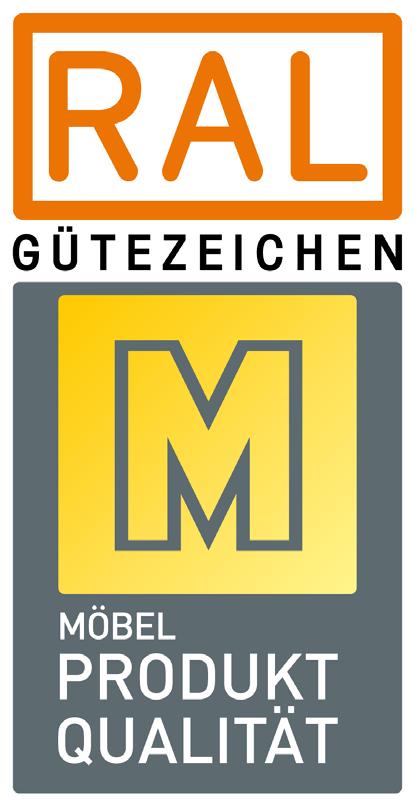
These Quality and Testing Regulations have been established by RAL Deutsches Institut für Gütesicherung und Kennzeichnung e. V. (RAL German Institute for Quality Assurance and Labelling) under the principles for quality labelling in a recognition process together with expert groups and responsible authorities.
Bonn, January 2022
RAL Deutsches Institut für Gütesicherung und Kennzeichnung e. V.


RAL-GZ 430 has been the “gold standard” for good furniture quality for more than half a century. However, its contents require constant adaptation in order to meet the needs of changing consumer requirements on the one hand and technical as well as social developments on the other. Standards, laws, and other recognised rules of technology are constantly changing. They are an essential part of RAL-GZ 430, which in its quality requirements, however, often goes beyond normative basic requirements.
With the claim of a holistic quality standard for furniture, RAL-GZ 430 includes in testable form the topics of processing quality, utility and comfort, product safety, healthy living as well as sustainability in product design and material selection.
The previously proven requirements and test methods have been adopted largely unchanged in this new edition of the RAL. In detail, however, changes, updates and adaptations were necessary, based on the experience in dealing with this set of rules and due to changes in standards which are referenced in this RAL.
As the person responsible for the editorial processing of the results of the DGM working groups, I would like to express my special thanks to the staff of these working groups as well as to the editorial team of the DGM. Without the dedicated cooperation and competent contributions of the voluntary DGM working group participants, further development and updating of RAL-GZ 430 would not have been possible.
Reimund Heym Head of Technology and Standardisation
It all started with RAL-GZ 430. It is the basis for the “Golden M” certification, which focused on quality, function, and environmental compatibility early on. It was and still is a matter of consumer protection.
I am all the more pleased that the Deutsche Gütegemeinschaft Möbel e. V. recognised early on that quality, and thus durability, is an essential part of sustainability. Various certification offers in this area followed, whether it was climate neutrality or emission measurements of the products. Then, in 2019, very consistently, the Advisory Board for Sustainability was founded to meet the everincreasing pressure for change, which was also of a legislative nature. Today, sustainability is no longer a trend, nor is it a megatrend, but a must, an imperative.
We need to recognise that companies are part of the environment and part of society, that we are all part of a system with interdependencies, no matter what we do or don’t do. Sustainability management is a journey that never ends for companies. With its various certifications, the DGM offers companies goals and intermediate destinations for this journey, and thus also offers the end-consumer reliable information on the subject of sustainability. With this in mind, I am honoured to be able to shape the future with the wonderful people on the Advisory Board and I look forward to continued constructive discussions leading to results for the good of all.
Dr Susanne Steinhauer Chairwoman Advisory Board for Sustainability6.4.1.


6.4.3.
6.4.4.
6.4.5.
6.4.6.
6.4.7.
6.4.8.
6.5.
6.5.1.
6.6.
6.6.1.
6.6.2.


These Quality and Testing Regulations apply to the condition of furniture for the office and contract sector 1 that may be labelled with the RAL quality mark. All legal regulations must be observed as a matter of principle. In addition, quality assured furniture must meet the requirements as defined below. All standards relating to the scope of these Quality and Testing Regulations shall be consulted as well.
Only the most recent versions of standards or their relevant replacements are valid.
The requirements take into account as standard climate according to DIN 50014 a temperature of 23° C and a relative humidity of 50% and apply to furniture in new condition.
At the time of publication of these Quality and Testing Regulations, the DIN 68890 standard is being revised. Upon publication of this standard, the requirements contained therein shall be considered binding, provided that they do not fall below the values specified in these Quality and Testing Regulations.
Proper transport and professional assembly of the products are assumed.
The basic requirements for quality assured furniture are regulated by the relevant standards and guidelines of the Quality and Testing Regulations, compliance with which is mandatory as a prerequisite for initial testing according to Section 3.1.
Furniture that contains functional and constructional elements not included in RAL-GZ 430 must conform to current technological standards
Monitoring is divided as follows:
• Initial testing
• Internal quality control
• External quality control
• Repeat testing
• Testing and monitoring reports / Approval license
• Testing costs
1 Where the term office furniture is used below, this also includes furniture for the contract sector.

3.1.
• Inspectors
Passing the initial test is one of the requirements for the award and use of the quality mark of the Quality Association. Initial testing is carried out in the production facilities of the applicant. As part of this assessment, random laboratory test samples are taken from ongoing production by the commissioned third-party inspector. If the applicant can provide test certificates for supplied products or materials, the test procedure is reduced. It is, however, important that these documents (test certificates may not be older than 1 year) are based on the current technological standards and the tests were carried out by competent and neutral testing institutes.
3.2.
Ongoing internal quality control, which can be reproduced at any time, is mandatory for all quality mark users. Users must carefully record the results of internal quality controls, keep them for at last 5 years and present them to the appointed inspector for inspection upon request within the scope of external quality control procedures
3.3.
In order to ensure the consistent quality of quality assured products, external quality control is carried out every 2 years on the premises of the quality mark user. Within the first 3 years of awarding the quality mark/membership, external quality control is carried out annually. This test covers the inspection of the results of all quality control measures (e. g. internal quality control, test reports from competent, neutral testing institutes) and the inspection of the proper manufacturing of “quality assured office furniture”.
3.4.
If deficiencies in the quality assurance are detected during external quality control measures, the Quality Committee can order a repetition of the test, whereby the type, content and scope of this test are determined by the Quality Committee of Deutsche Gütegemeinschaft Möbel e. V. Should the repeat test also conclude with a negative result, the Quality Committee may, in agreement with the Executive Board, take further measures in accordance with Section 12.5 of the Implementing Regulations for the Award and Use of the Quality Mark
3.5.
The contracted external inspectors must draw up corresponding test reports on the tests and quality control procedures carried out; the applicant or quality mark user each receive copies of said reports.

Based on the passed tests, the DGM office issues an approval license for the furniture programs listed therein for a certain term
3.6.
The applicant or quality mark user must bear all arising testing or monitoring costs.
3.7.
The Quality Association appoints suitable, expert testing institutes to carry out tests and monitoring measures.
Institutes entrusted with this task must prove their identity to the applicant or quality mark user by submitting a written identification before starting their work.
Sustainability is to be understood as a development that is ecologically compatible, socially just and economically efficient.
Important in this context is a long product life, which can only be achieved through high quality, which contributes significantly to saving resources and which is therefore an essential part of sustainable economic activity. Another aspect of sustainability is the consideration of social impacts.
Sustainability as well as the environment and personal health are particularly important to consumers today. In close cooperation with leading testing institutes and taking into account more recent specifications of the Federal Environment Agency, the requirements were revised and adapted to the latest scientific findings.
These requirements apply to office furniture as purchasable by consumers in furniture stores. Manufacturers must ensure that all supplied materials (including those from abroad) comply with the statutory European and German regulations (e. g. Chemicals Act, Banned Chemicals Ordinance and Ordinance on Hazardous Substances, REACH POP) as well as additional DGM requirements.
In case of mandatory normative, legal, safety-relevant as well as contractual specifications regarding the use of materials, substances and requirements, the effects on the requirements according to RAL-GZ 430, especially in the contract sector, are not taken into consideration.
The initial and monitoring tests are to be carried out according to Point 3
The preparations (paints, adhesives, stains, coatings, etc.) must not contain substances of the following categories as formulation components:

Substances according to Regulation (EC) No 1272/2008 (CLP Regulation):
Categories Carcinogenic 1A and 1B, Mutagenic 1A and 1B, Toxic to reproduction 1A and 1B
a) Sensitising substances according to the Technical Rule for Hazardous Substances (TRGS) 907 and the EC Regulation 1272/2008, Annex VI
b) Substances which are of very high concern for other reasons, and which have been included in the list (so-called candidate list 1) established in accordance with REACH Article 59(1)
c) Acutely toxic (poisonous) of the category Acute Tox. 1 or Acute Tox. 2
d) Toxic to specific target organs of the category STOT SE 1, STOT SE 2, STOT RE 1, or STOT RE 2
Excluded from these regulations are:
a) Process-related, technically unavoidable impurities that are below the classification limits for mixtures.
b) Monomers or additives that react to form polymers or are chemically bonded (covalently) into the plastic during plastic production if their residual concentrations are below the classification limit for mixtures.
4.1.1.
The examinations in test chambers can be carried out both as whole-body tests and as component tests. The selection of test samples is to be agreed between the testing institute and the manufacturer and is to be carried out in such a way that all model variants awarded the quality mark are represented by the test
4.1.2.
The final products falling within the area of application differ in shape, materials and the number of materials used. Therefore, in each individual case, the test procedure and the selection of test samples must be determined by the testing institute responsible for the surveillance test in consultation with the manufacturer.
For furniture made of wood and wood-based materials with a three-dimensional surface, there are two ways of testing:
a) Whole-body testing, especially for small furniture, chairs, etc.
b) Component testing, especially for modular furniture and furniture programs with similar components.
1 Link to the candidate list of Regulation (EC) No 1907/2006 on the Registration, Evaluation, Authorisation and Restriction of Chemicals (REACH): https://echa.europa.eu/de/candidate-list-table

4.1.2.1.
The product to be tested must be taken directly from current production. Supplied parts may not be older than 10 days. A deviation from this specification is permissible if the manufacturer proves that individual supplied parts used in the normal production process are regularly older than 10 days.
Immediately after removal from production, the product must be placed in airtight packaging; modular furniture must be packed in closed state.
Note:
During component testing, it is permissible to use the following calculation formula to extrapolate the total concentration of complete products consisting of known area segments of the tested components, based on the established concentrations of volatile organic compounds of the individual components.
The proportionate areas of the total product must be calculated for each component and entered into the formula with the emission values determined:
Ccalc. = Calculated total concentration for complete product in µg/m³
n = Number of components tested
i = Compendent index
Ai (%) = Area share of the i-th component in %
Ci = Concentration of the i-th component in µg/m³
This method can be foregone if none of the tested components exceed the permissible emission values or if the entire product is tested
4.1.2.2.
In the case of component testing, e. g. for furniture programs, the testing institute selects the components to be tested in consultation with the manufacturer. The different materials used, in particular different coating systems, must be taken into account. The selection must be made in such a way as to ensure compliance with the requirements of the award criteria for the product to be tested. In the case of components with a total area share of no more than 5% of the product, sample analyses and emission testing are not necessary.
The components to be tested are be taken directly from the current production in sufficient quantity. Supplied parts may not be older than 10 days. A deviation from this specification is

permissible if the manufacturer proves that individual supplied parts used in the normal production process are regularly older than 10 days. In the case of flat components, at least 3 parts must be taken as a stack, of which only the middle part is used for the emission test. The testing institute has to be consulted about the exact sample quantity, taking into account the size of the component and the emission test chamber to be used. The samples taken from the same components must be immediately packed together in airtight packing. The individual samples should be placed as close to each other as possible in order to minimise unavoidable emissions during transport to the testing institute.
The packaged sample material must be transported to the testing institute as quickly as possible. No more than 7 days may elapse between packaging and arrival at the testing institute.
4.1.3.
Until the start of the test, the test sample or sample material must be stored at the testing institute in packaged form.
When preparing the test samples for the emission test, only those flat components should be used that are stored on the inside of the stack and not those on the outside.
Components and complete products can be tested in their original condition in a large test chamber. In this case, possible low results for semi-volatile compounds must be taken into account. As a rule, test samples are to be taken from the sample material which can be examined in a test chamber suitable for volatile organic compounds. The test samples should represent the materials used and the different surfaces of a complete piece of furniture. Any narrow surfaces exposed by cutting must be sealed with a suitable sealant.
Self-adhesive, low-emission aluminium foil has proven suitable for this purpose. Any selfemission of the aluminium foil must be determined in preliminary tests.
When calculating the emission area, the surfaces on both sides and the narrow surfaces (without surfaces subsequently sealed as a result of test sample cuts) must be included.
After completion of the test samples, they must be immediately placed in the test chambers or stored in packages until the test chamber is loaded.
For the manufacturer's own internal documentation, a sampling protocol (dates of production, packaging, shipping, etc.) must be created for each sample.
The time between packaging of the samples at the manufacturer and loading of the chambers should be as short as possible. According to DIN EN 16516, the test must be started within 8 weeks after sampling, provided that the sample is stored in the laboratory in the specified

packaging and under normal indoor conditions. Sampling, sample receipt and test start must be documented in the test report
4.1.4. Emission requirements for contract and office furniture
Table 1 – Emission requirements for contract and office furniture
Parameters
Other acc. to current list of LCI values 2)
TVOCspec. (C6 – C16) acc. to AgBB 2) Only box furniture < 3000 µg/m³ < 50 µg/m³ < 450 µg/m³ <
TSVOC (<C16 – C22)
µg/m³ < 600 µg/uh
CMR- substances 3) acc. to EU Cat. 1A and 1B ∑ < 10 µg/m³ < 1 µg/m³ per individual value < 1 µg/m³ per individual value < 1 µg/m³ per individual value
Odour (see explanations below) < 3.0 < 3.0 < 3.0
VOC without LCI
acc. to AgBB 2)
R value 4) < 1 < 1 < 1
1) The test can be terminated on the 7th day after loading if the required final values of the 28th day are reached and no increase in concentration of one of the detected substances can be detected compared to the measurement on the 3rd day.
2) Sum of all individual substances ≥ 5 µg/m ³) at test chamber concentration
3) The substance Dimethylformamide (DMF, CAS 68-12-2) is treated separately during the assessment of CMR properties. For DMF, a limit value (based on the LCI value) of < 15 µg/m³ after 28 days applies. The value after 3 days shall not be included in the total evaluation. For the calculation of the R value, DMF must still be taken into account. This regulation is valid for a transitional period until 31.12.2023. As of 01.01.2024, it will no longer apply.
Formaldehyde and acetaldehyde are excluded from the CMR assessment (classification: Carc. 1B).
4) The R value is based on the current list of LCI values according to AgBB; https://www.umweltbundesamt.de/sites/default/files/medien/4031/dokumente/agbb_bewertungsschema_2021.pdf

Definitions of TVOCspec und TSVOC
TVOCspec:
Sum of all individual substances found ≥ 5 µg/m³ in the retention range C6–C16 (between nhexane up to and including n-hexadecane). The determination is carried out in accordance with the currently valid AgBB scheme. Data in the AgBB scheme for C substances apply here to CMR substances of category 1A and 1B.
TSVOC:
Sum of all individual substances ≥ 5 µg/m³ in the retention range > C16–C22. In individual cases, LCI values have been derived for SVOC. The SVOCs for which LCI values have been determined are to be included in the R value calculation for the requirements after 28 days and are no longer subject to the sum SVOC value. The sum of the TVOCspec value and the sum of the individual SVOC with LCI value must not exceed the TVOC requirements after 28 days (AgBB procedure).
General information on TVOC and TSVOC:
The basis for measuring the emission of volatile organic compounds and formaldehyde is the BAM test method in the current version. The requirements for the test chamber procedure and the analysis are based on DIN EN 16516 in conjunction with the DIN EN ISO 16000 et. seq. series of standards.
4.1.4.1. Odour
The odour test shall be performed after a minimum of 3 and a maximum of 28 days of residence time in the test chamber. In case of a previous test according to Point 4.1.4 testing can be carried out after the previous test is completed. In the case of several tests, the result of the last test series (longest period in test chamber) is definitive.
Requirements:
Score to be maintained: Level 3.0
The majority of individual scores must not be above level 3.0. The average must be ≤ 3.0.

Testing:
Odour neutral room:
Temperature: 23° C ± 1° C
Humidity 50% r. h. ± 5% r. h.
Airflow rate: Depending on the type of test sample
Chamber volume: The chamber volume is based on the specified test chamber size (Table 1)
Room loading: Depending on the type of test sample
At least 7 test persons independently assess the odour intensity according to a 5-point scale:
1 = no odour
2 = weak odour
3 = distinctive, not unpleasant odour
4 = unpleasant odour
5 = unbearable odour
The following should be recorded:
• Age and sex of test persons
• Room size
• Room temperature
• Room humidity (rel. humidity)
• Date of assessment
• Time span between production and odour assessment
• Type of odour
Test persons: The test persons (at least 7 persons, at least 3 of them women) should spend at least 10 minutes in a room with clean air before the odour test. The odour assessment is performed undiluted. The test persons should not have any previous exposure to the odours to be evaluated.
Mean value:
Of all the individual values determined, one highest and one lowest are not to be used for averaging. Only the mean value is given in test reports

4.1.5. Additional material requirements
4.1.5.1. Chlorophenols
Pentachlorophenols / Tetrachlorophenols / Trichlorophenols
Test specimen: wood-based materials
Requirements:
Table 2 – Values to be maintained for individual biocides
Wood-based materials < 3 mg/kg < 3 mg/kg
Method of analysis:
The sample is heated with 1 m KOH in a drying oven. An aliquot of the extract is derivatised with acetic anhydride. The derivative is extracted with n-hexane and analysed on capillary GC by ECD. Other methods are permitted if comparability has been demonstrated.
4.1.5.2. Dispersion dyes and pigments
Requirements:
• Carcinogenic dyes
• Mutagenic or teratogenic dispersion dyes
• Potentially irritating dyes
• Dyes containing heavy metals are not permissible
Testing according to DIN 54231
Proof via manufacturer’s declaration possible.
4.1.5.3. PAH (Polycyclic aromatic hydrocarbons)
Testing and evaluation according to AfPS GS 2019:01 PAC
GS Specification “Testing and Evaluation of Polycyclic Aromatic Hydrocarbons (PAH) in the Award of the GS Mark” of the Product Safety Committee (AfPS) as of April 2020 or the respective current regulation.
Proof via manufacturer’s declaration possible.

4.2. Protection of environment and climate
4.2.1. Energy and eco-balance
The efforts of manufacturers to minimise the energy and atmospheric environmental impact associated with the transport of their products and supplier materials must be evident from appropriate documents.
The use of self-generated, renewable energy (e. g. burning waste wood) and the purchase of CO2 neutral energy are to be preferred.
To optimise the use of materials and energy with regard to a sustainable eco-balance, the implementation of a life cycle assessment based on the systematics of the standards DIN EN ISO 14001, DIN EN ISO 14040 and DIN EN ISO 14044 is suitable.
A life cycle assessment or environmental declaration of the products according to DIN EN ISO 14025 (EPD verification) is also recommended.
4.2.2. Human and ecosystem health
In addition to the legal regulations on the handling of chemicals that are harmful to humans and the environment (e. g. REACH Regulation), this Furniture Quality Assurance RAL-GZ 430 contains extensive testing requirements to ensure furniture that has been tested for harmful substances
4.2.2.1. Liquid coating systems
Operators of coating plants must comply with the requirements of the 31st Federal Imission Control Act (BlmSchV). This shall be proven via the manufacturer’s declaration
4.2.3. Use of materials
4.2.3.1. Solid wood and wood-based materials
Solid wood and wood-based materials must comply with EU Regulation 995/2010 and, as far as possible, originate from sustainably and legally managed forestry (FSC/PEFC documentation). When using waste wood in wood-based materials, the Waste Wood Ordinance must be observed. Proof of the pollutant limit values of the Waste Wood Ordinance according to testing in compliance with the EPF standard.
4.2.3.2. Plastic components
Plastic components > 50 g should be labelled according to DIN EN ISO 11469 and should not contain additives of other materials that conflict with recycling.
4.2.3.3. Adhesives
The VOC content of adhesives should not exceed 10% for water-based systems and 30% for solvent-based systems.

4.2.3.4. PVC
The use of PVC should be limited to furniture parts for which no equivalent other materials are available and for which the special properties of PVC are required.
The use of PVC must be indicated in the product information (PI). Dismountable PVC parts are exempt from this regulation if they are clearly marked as PVC parts
4.2.4. Circular economy
4.2.4.1.
The principles of recycling-friendly design (VDI 2243) must be observed. The use of recyclable and biodegradable materials is to be preferred.
For wear parts, a functional, compatible replacement is ensured over a period of at least 5 years.
The durability of the products shall be ensured by appropriate design.
4.2.4.2. Packaging
The packaging material must be suitable for reuse or recycling. The packaging must be designed in such a way that any volatile components of the furniture can outgas.
4.2.4.3. Reusability / recycling
With regard to reusability and recycling, no material preservatives (fungicides, insecticides, flame retardants) and no halogenated organic compounds may be added to the furniture, or the materials used for its production (wood-based materials, adhesives, coatings, etc.).
This excludes fungicides used solely for in-can preservation in water-based coatings and glues or flame retardants in which inorganic ammonium phosphates (diammonium phosphate, ammonium polyphosphate, etc.), boron compounds (boric acid, borates) or other waterreleasing minerals (aluminium trihydrate or similar) are used for flame retardation.
4.3. Social responsibility
With a view to sustainable human resources development and to ensure health, occupational safety and social working conditions, a company should, in accordance with good management practice, define and document responsibilities and procedural rules concerning this matter
• These include in particular:
• Fair hiring practices
• Continuing education of employees
• Social responsibility in company regulations

Social ethics may also include social measures for the local environment of the operating site (e. g. sponsoring cultural or charitable institutions).
Compliance with the requirements can be achieved through membership of the UN Global Compact 13.14 or equivalent certificates. The Deutsche Gütegemeinschaft Möbel supports the UN Global Compact and its 10 principles. These guiding principles for business and human rights are to be implemented by the quality mark users. The implementation is documented during the monitoring audits.
With regard to social responsibility for products of the supply chain over which the company has no direct influence, preference is to be given wherever possible to supplier companies that take social standards into account.
Advertising claims must not contain any statements such as “biologically tested” or similar statements that play down hazards as laid out in the EU Directive 67/548/EWG Article 23 (Designation) Section 4 (e. g. “non-toxic”, “no risk to health”, “free from ”).
It is a prerequisite for “furniture with the quality mark” that suitable materials and construction elements are used which are appropriate to the product and have been professionally processed. Safety, function, and utility are assessed according to the latest standards of technology at the time of product launch. Environmental and health protection as well as product information are essential quality features.
Deviations from the requirements laid out in the Quality and Testing Regulations may be made if an equivalent or higher quality and safety objective is achieved by other means. Suitable proof is required
Visual inspections are carried out under the following conditions (unless otherwise specified):
General assessment: At distance of 2 to 3 m
Detailed assessment: At distance of 0.7 ± 0.1 m
Assessment basis: normal vision; diffuse daylight (without direct sunlight or artificial light).

Parts that are not visible in the position of use or subordinate parts as well as irregularities that are only visible in grazing light are excluded from the assessment
The product information for office and contract furniture shall be made available to the retailer for marketing purposes and for passing on to the end customer and contains the following details based on RAL-GZ 430/8:
1. Product name
2. Product label*
3. Structural design
4. Materials
5. Surface treatment
6. Model variants
7. Dimensions
8. Weight
9. Maximum load
10. Cleaning and care instructions
11. User information**
*Labelling obligations according to the Product Safety Act (ProdSG) must be observed.
**User information in accordance with DIN EN 82079-1 must be supplied where necessary.
Visual inspection, laboratory test
In addition, the following information, if applicable, should be included in the product information:
• Information on wear parts and their repair or replacement, repair service if necessary (For wear parts, a functional compatible replacement of at least 5 years is guaranteed).
• Information on the type and origin of the wood predominantly used.
• Information on other materials (proportion > 3 weight percent)
• Information on the assembly of the products and disassembly for removal and subsequent material recycling. For special product groups, the Eco Design Directive (2009/125/EC) must also be observed.
• In the case of furniture that falls under the Electrical and Electronic Equipment Act (ElektroG, see annex 13.6), appropriate labelling must be applied to the furniture and the method of disposal must be indicated in the operating instructions.
• If PVC must be used, this must be stated in the product information.

6.1. General provisions
6.1.1. Material-specific characteristics
The material-specific characteristics of office furniture are regulated by special requirements according to DIN Technical Report 147.
Deviations in the panels and the coating material used must be recorded in the product information or agreed with the customer.
The requirements for office furniture must be met by all materials used (if necessary, proof by manufacturer’s declaration).
6.1.2. Safety and ergonomic characteristics
Office furniture shall in principle be designed and constructed in such a way that the ergonomic functionality and variability as well as the safety-related design enable an optimal office workplace.
In conjunction with the other testing regulations for office furniture, these functions and characteristics are to be designed for a long service life with appropriate use.
For cabinets intended specifically for the contract sector (e. g. accommodation, youth hostels, conference centres, etc.), the requirements according to DIN EN 16121 must be complied with to prove safety.
6.2. Applicable ergonomic, dimensional, testing and safety standards
(For the standards and regulations outlined below, the relevant current version applies.)
6.2.1. Office work desks, cabinets, room dividing elements
DIN Technical Report 147 Requirements and testing of office furniture
DIN EN ISO 9241-T5
Ergonomic requirements for office work with monitors
Part 5: Requirements for workplace design and posture
DIN EN 527-1 Office furniture, office work desks, dimensions
DIN EN 527-2 Office furniture, office work desks, mechanical safety requirements
BGR 234 Storage equipment and devices
DGUV 215-410
Monitor and office workstations, guidelines for design
DIN VDE 0100, Part 713 Electrical installations in furniture
DIN EN 60335-1
Safety of electrical appliances for household use
BSO Guideline for electrical installation in office furniture Compilation of recognised rules of technology
DIN EN ISO 13857
Safety of machinery; Safety distances to reduce risk of
squashing/ clamping body parts in danger zones

DIN VDE 1000
General principles for the safe design of technical products, (identical to DIN 31000) minimum distances, crushing and shearing points
DIN EN 14073-2
DIN EN 14073-3
DIN EN 14074
DIN EN 15372
DIN EN 16121
DIN EN 16122
DIN EN 1023-1
DIN EN 1023-2
DIN EN 1023-3
DIN EN 1730
ZLS / EK5/AK3
ZLS / EK5/AK3
ZLS / EK5/AK3
ZLS / EK5/AK3
VDS 2024
6.2.2. Office work chairs
Office furniture, cabinets, safety features
Office furniture, cabinets, stability, and strength of construction
Office furniture, office work desks and cabinets; determination of strength and durability of moving parts
Tables for non-domestic areas, durability, and safety
Storage furniture for non-domestic areas - Safety, strength and durability requirements
Storage furniture for non-domestic areas – Test method for the determination of safety, strength, and durability
Room dividing element - Dimensions
Room dividing element - Mechanical safety requirements
Room dividing element - Testing
Tables – Test methods for determining stability, strength and durability
Basic principles for testing the safety and ergonomic features of sitting/standing work desks
Basic principles for testing the safety and ergonomic features of office furniture on casters
Basic principles for testing the safety and ergonomic features of the work surfaces of work desks
Basic principles for testing the safety and ergonomic features of screen support arms
Erection of electric installations in furniture and similar furnishings
DIN EN 1335-1 Dimensions
DIN EN 1335-2
DIN EN 16955
Safety requirements including user information
Testing of gas springs
6.2.3. Visitor chairs for the contract sector
DIN EN 1728
Seating furniture – Test method for determining strength and durability

DIN EN 16139
DIN EN 1022
DIN 68878
Seating furniture for non-domestic areas – Requirements
Furniture – Seating furniture – Determination of stability
Chairs for domestic use, performance characteristics –Requirements and test methods
6.2.4. To be considered in office planning
DIN 16555
DIN 4543-1 (withdrawn)
DIN 15906
Office workplace – Areas for communication places in office and administration buildings
Office workplaces – Areas
Conference facilities
The overall appearance of a piece of furniture is determined by the level of decorative design and the quality of workmanship. These criteria are examined and assessed as “technical quality features” according to objective aspects within the framework of furniture testing.
In contrast, the aesthetics of a piece of furniture depends greatly on the subjective perception of the observer or user. The aesthetics of a piece of furniture cannot be judged according to technical parameters. It is a question of individual taste, which is influenced by fashion trends, the environment, personal image needs, and art and taste sensations, among other things.
6.3.1. External design
Visual assessment of the overall appearance and metrological inspection of connections, dimensional accuracy, evenness, uniformity, colour design.
Essential test criteria:
• Dimensions for office work desks according to DIN EN 527-1
• Evenness of front and side surfaces, work surfaces
• Joint width (deviations)
• Alignment line of doors, flaps, and drawer fronts
• Design of corners and edges according to DIN Technical Report 147
• Uniform colour design
Requirements:
• Optimum external appearance
• Compliance with coordination dimensions or product information for other dimensions

• Perfectly fitting joints
• Uniformly even surfaces, max. permissible deviation 0.5% related to the distance between two corners
• Visually and technically good design of corners and edges, minimum radii 2 mm or 3 mm for desk top surfaces and topsides respectively
• Matching joints and parallel edges, deviation max. 2 mm per m edge length
• Matching alignment lines of doors, flaps, and drawer fronts; max. permissible deviation from alignment line 2 mm
• Good uniform colour design according to DIN Technical Report 147 (surface gloss max. 20 gloss units, surface resistance not less than 0.15 and not higher than 0.75)
6.3.2. Material selection and workmanship
Visual inspection of appearance, findings and quality of the materials used as well as the quality of workmanship
Essential test criteria:
• For solid wood: quality-reducing knots, tree edges, worm marks, wood rot
• For panel material: defects in coatings and veneers
• Uniform material quality
• Processing quality of the materials
• Selection, use and installation of high-quality fittings
Requirements:
• No imperfections
• No quality-reducing phenomena
• Visually and professionally flawless workmanship of all materials
• Correct selection, use and installation of appropriate fittings (for loads see corresponding standards)
6.4. Strength, durability
6.4.1. Hinged doors, swing doors, hinges
With regard to the testing and assessment of moving parts of the furniture (e. g. drawer runners) as well as other load-bearing construction elements (e. g. shelves or shelf supports), various requirements and test methods of DIN EN 14073/2-3 as well as DIN EN 14074 and DIN Technical Report 147 must be observed.

6.4.2. Room dividing elements
The same test conditions which apply to other office furniture also apply to room dividing elements For systems that are permanently connected to the structure (room dividers), the building regulations apply. Special requirements for movable partitions and partition systems: Additional testing according to DIN EN 1023/3.
Static load capacity (deformation test)
Test conditions:
Movable wall fixed on one side at the top and bottom
Opposite side fixed at the bottom, at the top under horizontal load deflection of the movable wall by 200 mm or with a force 200 N – see picture, load after each side 5 min.
Requirements:
No permanent deformation after unloading, functional safety must be guaranteed.

Durability of the construction
Test conditions:
Movable wall fixed at the top and bottom on one side
Bending fatigue load test by applying a load of 200 N at half the height of the movable wall, on the side that is not fixed at the top – see picture
Max. deflection to each side: 100 mm
Load change: 1,000
Requirements:
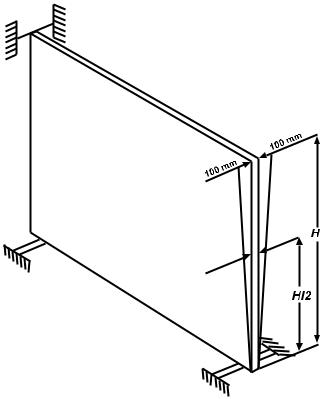
No damage or fractures to the corner connections and positioning elements, unit should be fully functional after endurance test.

Dynamic load capacity
A dynamic load capacity test is carried out in the same manner as described in the drop test. In addition, the movable wall surface is tested against hard impact.
Test conditions:
Movable wall mounted horizontally with 2 longitudinal edges on a rigid base,
Impact body 1: steel ball 1 kg (ø 63 mm),
Impact body 2: sandbag with 20 kg (ø 200 mm),
Drop heights: 400 mm, 600 mm,
Impact load: 1 load per drop height and impact body with point of impact at the centre of gravity of the surface.
Requirement:
No permanent damage to the deformations
Stability
Testing of non-upgradable and upgradable room dividing elements according to DIN EN 10233 Point 6.
Strength of upgradable elements
The strength test of upgradable elements is to be carried out according to DIN EN 1023-3 Points 6.3. and 6.4.
Requirement:
No damage when lowering 1/100 of the depth of the element.
6.4.3.
Locks must be positioned in such a way that injuries are avoided. According to DIN Technical Report 147, locks on cabinets and base units must be fitted at the front. As a matter of principle, no locks must protrude in the leg space of tables.
The effect of all loads occurring in practice, such as transverse forces, counterforces when closing on the latch, etc., are taken into account in the test.
The test is carried out on the finished furniture in accordance with DIN EN 16014.
Locking systems must allow at least 100 different lockings or the different number of lockings must be agreed.

Test conditions:
Torque and closing resistance are determined before and after the durability test:
10,000 operations without additional load
3,000 operations with 0.5 kg additional load
2,000 operations with 1.0 kg additional load
Additional load applied to the original key shaft or rotary knob in each case
Requirements:
Functional safety guaranteed, locking resistance max. 50 Ncm (with door open).
Overtightening test
Test conditions:
According to DIN EN 16014 the lock is overtightened with 160 Ncm.
Requirements:
Functional safety guaranteed.
Pull-out resistance
Test conditions (acc. to DIN EN 16014):
Test force on lock: 300 N
Test force on rod bearing: 200 N
Load duration: 10 s
Unloading duration: 120 s
Cycles: 5 loads
Requirements:
Max. permissible lift-off from the support material 2 mm
6.4.4. Durability of the construction joint
Durability test
Test conditions:
• Individual pieces of furniture fixed to the floor with 10 mm open adjusting elements, without preventing movement.

• Additional load for tables Fv = max. 1,000 N (centre of surface, evenly distributed), Test weight ø 350 mm
• Additional load for cabinets: F = 1.5 kg/dm2 (all shelves evenly loaded)
• Horizontal force (alternating load): 300 N
• Force application: see picture
• Step sequence: 1, 2, 3, 4 (lengthwise, lengthwise, crosswise, crosswise)
• For round or oval conference tables, the force application is analogous.
• Cycles: 5,000
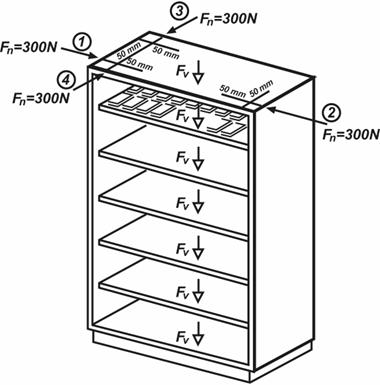
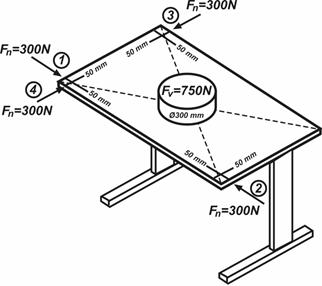
Requirements:
Max. permissible deflection under horizontal load max. 2% related to the force application height.
Note: Retightening of fastening screws permissible.
Dynamic test (drop test)
Test conditions:
Individual pieces of furniture (office desks and cabinets) tilted over narrow side according to picture (test based on DIN EN 1730 Point 6.9.)
Drop height according to DIN EN 527-2
Frequency: 2 times over each of the two narrow sides
Test surface: concrete floor with PVC overlay (1.5 mm thick)
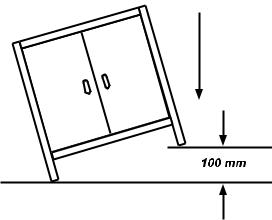

Requirements:
No visible changes permitted; functional safety must remain unaffected.
Static load capacity, deflection of table and work surfaces
Test conditions:
• Static load of drawers, pull-outs, shelves, and inserts
• Static load of table and work surfaces (deviating from DIN EN 527-2)
• Table or work surface centre loaded with test weight
• Test weight: 75 kg, outside ø 350 mm
• Additional load: for office desks, cabinets with work surfaces etc., the additional load depends on the respective loads of the containers.
• Load duration: 7 days
Requirements:
• Max. permissible deflection under test load: 1/100 (related to panel length)
• Max. permissible permanent deformation: 3 mm
• Max. permissible inclination of the work surface for skid tables: 2%, measured at test load (see picture)
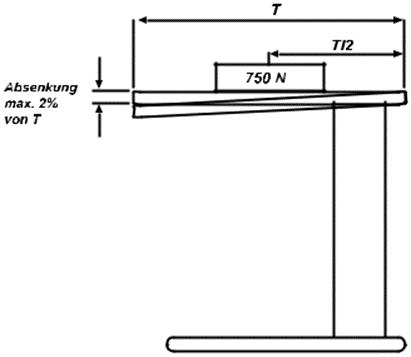
Note: Protruding tabletops and their fastening must be constructed in such a way that the unloaded table (dead weight) can be lifted at any point on the tabletop (requirement according to DIN Technical Report 147) and that it is possible to move the table in the room
Strength and fatigue under vertical force application
Testing according to DIN EN 527-2

Requirement:
No visible changes, functionality must remain unaffected
6.4.5. Furniture casters
Casters adapted to the weight of the loaded furniture must be used. The casters must meet the requirements of DIN EN 12528 or DIN EN 12530
6.4.6. Durability of pull-out stops
Test conditions:
Pull-outs loaded with payload; 1 pull-out fully extended; further pull-out on the actuating element loaded with tensile force to the outside.
• Tensile force: 100 N (threshold load)
• Load frequency: 5,000
• Test frequency: 15 min-1
Requirements:
Pull-out stop functionally reliable, actuating elements without damage
6.4.7. Freedom from vibrations
Test conditions and requirements based on DIN Technical Report 147.
The design must ensure that no disturbing vibrations occur in office work desks. This requirement is deemed to be fulfilled if the values for the permissible deflection (S permissible) given in Table 1 (DIN Technical Report 147) are not exceeded during the test with a pendulum impact hammer with an energy of 10 Nm.
Permanent deformation must not occur.
6.4.8. Foot levelling and floor loading
Office furniture must include a device to compensate for floor unevenness.
Test conditions:
The surface pressure is calculated over the supporting surfaces of the loaded furniture (loading according to DIN EN 14073-2). Supporting surfaces are pedestals, legs, and casters
Surface pressure = F1 + F 2 N/mm2

F1 = Dead weight force (N)
F2 = Specific load (N)
A = Total supporting surface of the stand elements (mm2)
Requirements:
Floor levelling min. 10 mm
Surface pressure = max. 4 N/mm2
Other values are to be specified in special agreements. In case of dynamic loads, e. g. due to vibration, pedestal constructions are recommended to avoid floor damage.
Office furniture, contract furniture and work furniture of all kinds are subject to the provisions of the Product Safety Act (ProdSG). Accordingly, the basic safety, occupational health and ergonomic requirements laid down in the relevant standards and safety regulations apply bindingly to all such furniture.
In addition, the goal for high-quality office furniture is to achieve optimum ergonomic functionality and variability.
6.5.1. External design, corners, edges, shaping, surface
Test conditions:
Haptic, metrological, and visual testing:
• Corners and edges of work surfaces (all accessible working edges) with which the user comes into contact during intended use and reasonably foreseeable misuse
• Shaping in leg area and head area (wall cabinets)
• Shaping in containers (drawers, shelves, baskets, etc.)
• Shaping of accessible fitting parts
• Surface finish with regard to roughness
• Surfaces with which the user is in constant contact, especially the worktop, must not allow any unwholesome heat dissipation
Requirements:
• Accessible corners and edges with minimum radius 2 mm
• Accessible corners and edges of tabletops with minimum radius 2 mm

• Material thicknesses not permitting these values must be free of burrs (see DIN ISO 13715)
• Avoidance of projections, corners and edges in the extended leg area, construction parts shaped with generous radii, no construction parts in the direct leg area, generous shaping in the accessible area of the head (wall cabinets in system furniture)
• No sharp-edged construction parts in containers
• Burr-free, optimally shaped, and rounded fittings
• Smooth and even accessible surfaces (except for design-related deviations that are not ergonomically disturbing)
• No unacceptable heat dissipation from work surfaces (thermal conductivity
≥ 0.7 watt/mK)
• Safety glass must be used for freely accessible vertical glass surfaces.
Safety distances, avoidance of pinching, crushing, and shearing points
Office furniture must be designed in such a way that, when used properly and in a foreseeable manner, there are no pinching, crushing, or shearing points on moving parts that could cause injury.
Based on DIN EN ISO 13857
Test conditions:
Testing of safety distances for moving parts:
• Adjustable tables, sitting/standing work desks
• Flaps, scissors, actuators
• Sliding doors
• Furniture with motorised adjusting parts, e. g. sitting/standing work desks
• Swivel and pull-out fittings
Requirements:
Opening width for fingertip < 8 mm or > 25 mm
Opening height for feet > 120 mm
Doors, flaps, and pull-outs including their hardware parts are excluded from this. The safety distances also apply to the distance between handles, knobs, and other parts.
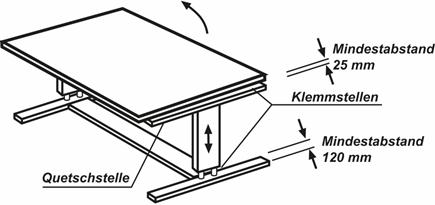
Securing moving parts (e. g. drawers and doors)
Test conditions:

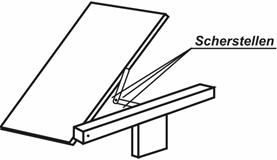
All detachable and moving furniture components are tested.
Essential criteria:
• Secure locking
• No automatic opening and closing of drawers, pull-outs, roller shutters and doors (with the exception of the self-closing mechanism)
• Drawers and pull-outs must be shock-absorbing to prevent them from being pushed in too far and to prevent them from falling out
• Doors, roller shutters, pull-outs and drawers must not be removed or unhinged when locked
• The securing of the moving parts must be sufficiently durable (verified by the functional life and wear test)
6.5.3. Ergonomic design
Ergonomic design of office furniture means that construction, conception, execution ,and use are carried out in such a way that an optimal adaptation to the working person is achieved.
Desk heights, legroom design
Test conditions:
Testing according to DIN EN 527-1, BGI 650
Requirements:
The minimum ergonomic dimensions must be observed.

Surfaces, surface gloss, surface brightness, heat dissipation
In the field of vision, glare due to shiny surfaces must be avoided and disturbing contrasts due to surfaces that are too bright or too dark must be ruled out (DIN Technical Report 147).
Test conditions:
• Testing of accessible and visible surfaces
• Condition (finish)
• Surface gloss: Exterior surfaces in the field of vision must not be glossy (gloss degree tables or reflectometer)
• Surface brightness: Exterior surfaces in the field of vision must not be too bright or too dark (reflectance tables or brightness metres)
• Heat dissipation
Requirements:
• Smooth surfaces that cannot cause injury when touched or permit distraction-free work (e. g. writing on work surfaces)
• Surface brightness (colour reflection) between 0.15 and 0.75
• Surface gloss max. 20 gloss units at 60° light incidence angle
• No unacceptable heat dissipation from surfaces with which the user comes into contact (thermal conductivity ≥ 0.7 watt/mK)
Noise generation of moving parts
Test conditions:
See test specifications for seated/standing workplaces
For partition walls, movable wall systems; testing of sound absorption for special equipment
Requirements:
For appropriately declared partition walls, room dividers and partition wall systems, sound absorption in accordance with the delivery agreement. The rating level at office workplaces should be as low as possible, taking into account the noise from outside.
Test conditions: (test criteria)
• Access area or access space for cabinets
• Access space for partial pull-outs
• Coordination dimensions with regard to file heights DIN A4 or hanging files DIN A4/A5

• Position of wall cabinets
Requirements:
Doors, sliding doors and roller shutters must be able to be opened to such an extent that the entire useable space can be accessed without hindrance (even when doors are open 90°, fixtures must be functional).
Partial pull-outs must allow at least 70% unhindered access.
Full-extension pull-outs must allow unhindered access to the full useable space.
The interior design of cabinets is free.
Test conditions:
The stability of office furniture must be guaranteed in every operating condition. This means that testing is carried out in the worst possible case, e. g. when all drawers, clothes rails, shelves etc. that can be pulled open at the same time are pulled out.
The furniture is loaded with loads from DIN EN 14073-3.
The stability test is carried out according to DIN technical report in deviation from DIN EN 5272 for tables and DIN EN 14073-3. In addition, the basic principles for testing the safety and ergonomics of office furniture on casters (except office seating) are to be applied. Furthermore, BGR 234 must be observed.
Requirements:
Furniture must not tip over.
Tables must be stable, even when loaded with 75 kg at the most unfavourable point of the tabletop.
Provided that they have sufficient load-bearing capacity and are set up vertically, the following can generally be considered stable:
Cabinets with hinged doors, if the height of the uppermost shelf is not more than 4 times the plinth or frame depth (see picture).
Cabinets without doors, sliding or roller blinds, if the height of the top shelf is not more than 5 times the plinth or frame depth (see picture).

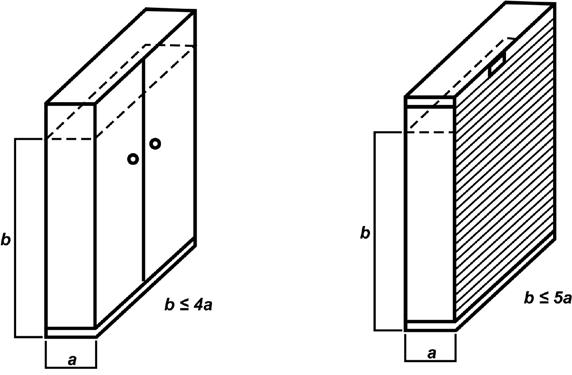

Room dividing elements
A device is used to apply a uniform increasing horizontal force, most unfavourable position, along a horizontal line of 1300 mm.
The applied force shall be increased gradually until either a maximum of 200 N is reached or the partition element is deflected 200 mm at the point of application of the force.
Note: Stability can be achieved by appropriate dead weight of the tables and cabinets, by pullout stops, by counterweights or wall fastening (here, holes must be drilled for the stable connection of the cabinets to each other or to structural elements).
6.5.5. Electrical safety
Electrical safety in general
Test conditions:
VDE 0100, Part 713, applies, with all tangential regulations depending on the equipment, as well as the BSO guideline for electrical installation in furniture.
Office furniture with electrical equipment and office furniture prepared for electrification are tested.
In the case of furniture subject to registration under the Electrical and Electronic Equipment Act (ElektroG), an appropriate marking must be made on the furniture and the type of disposal must be indicated in the operating instructions (see Guideline for electrical equipment / components in furniture 13.6).
Essential criteria:
• Cables, cable cross-sections
• Plug connections, other connections
• Mains connections
• Sockets
• Luminaires, other devices
• Installation ducts

• Installation requirements
Requirements:
The requirements according to the applicable VDE regulations must be adhered to.
Conductivity of electrostatic charges (special furniture)
Special workplace conditions require dissipative office and work furniture
Test conditions:
Testing is carried out in accordance with DIN EN 61340
Measuring voltage: 500 V DC
Conditioning: 24 h at 25° C, 30% rel. humidity
Measurement in conditioning climate
Or
Testing is carried out in accordance with DIN EN 12527 for wheels and casters according to ESP (Expertise Service Providers).
Requirements:
Good discharge capacity is present at discharge resistances: 103 Ω < R abl. < 109 Ω
6.6. Function and handling
6.6.1. Function of moving parts
Test conditions:
The function of all moving parts is tested under normal operating conditions on loaded and unloaded furniture, also after the durability test.
Requirements:
• Actuating forces max. 50 N, for payloads > 400 N max. 12.5% of the payload
• Low-noise
• Smooth-running
• Functionally reliable
• No soiling due to greased, oiled, or otherwise treated parts
• Unhindered function under load
• No functional impairment after durability test

• With convertible office furniture functional reliability even after 10-fold conversion
6.6.2. General and special requirements according to DIN Technical Report 147
Test conditions:
• Testing of ergonomic requirements for function and handling
• Floor levelling according to DIN Technical Report 147
Requirements:
• Ergonomic functionality
• Floor levelling of tables and cabinets (except pedestals): 10 mm
6.6.3. Cleaning, care, assembly and installation instructions
Factual technical information should contain all the following details required by the user (IEC/IEEE DIN EN 82079-1):
• Permissible working loads
• Surface resistance
• Care and maintenance
• Assembly, if necessary
• Operation
Accordingly, the effectiveness and conformity of the technical information for the respective office furniture or office furniture programme is checked.
6.7. Surface properties
6.7.1. Chemical and mechanical stress
The following stress groups correspond to requirements for normal conditions of use. In case of deviations, appropriate product information is required:
6.7.1.1. Painted materials
stress

68861 Part 2
68861 Part 4
6.7.1.2. Melamine resin coated surfaces (MFB, HPL, KF panels)
Requirement / testing acc. to DIN 68861
68861 Part 1
68861 Part 2
68861 Part 4
EN 438-2
6.8. Corrosion resistance of fittings and office steel furniture
Test conditions according to DIN EN ISO 6270-2: AHT (condensation alternating climate)
1 cycle: 24 hrs, in total 2 cycles
8 hrs: 40° C ± 3° C, 100% rel. humidity
16 hrs: 18° C (up to 28° C) with 100% humidity (e. g. 75%)
Requirements: No signs of corrosion on visible parts

7.1.
Office work chairs and visitor chairs must be designed in such a way that there is no risk of injury during use and that the ergonomic properties are fulfilled according to the state of the art.
This is ensured if DIN EN 1335-1, -2, DIN EN 16955 are complied with for office chairs and DIN EN 16139 for visitor chairs and DIN 68878 (20,000 cycles per load direction, 750 N overload) is also adhered to.
The tilt drop test is only to be carried out for four-legged chairs and conference chairs.
Note: For office chairs the bending fatigue method according to DIN EN 1335 Part 3, edition August 2002 (withdrawn) is applied.
Caster resistance test:
The caster resistance test for hard casters remains in deviation from the current version of DIN EN 1335 (requirement according to DIN 1335, Part 2, edition August 2012, withdrawn).
In addition to the legal requirements, office work chairs must also have the following features:
Minimum suspension
The chair must be equipped with a minimum suspension.
Testing:
The chair is adjusted once to the lowest seat height and once to the middle seat height, then a weight of 75 kg is dropped onto the seat surface from a height of 40 mm in each of these positions.
Adjust the drop height from the static sink-in point upwards. The dynamic reaction force must not exceed 4,500 N.
Surface pressure
Measurements with sedometer according to Ergonomic Testing Programme PfG 947/03.04 (TÜV Rheinland) Point 4.2; Requirement: < 3.0 N/cm2

Lifting the front edge of the seat
The front edge of the seat must not lift more than 20 mm when the backrest is tilted to the rearmost position.
Testing: according to PfG 947/03/04
Shirt-sliding effect
When leaning against the backrest, the relative movement between the back and the seat backrest must be limited.
Testing: according to PfG 947/03.04; relative movement < 1.5 mm/°
Upholstery / cover
Upholstery and cover must be permeable to air and water vapour.
Restoring force
The backrest must not spring forward in an uncontrolled manner.
7.3. Cover materials
Requirements and test methods
The respective requirements are taken from DIN EN 14465. The requirements take into account a wide range of different qualities.
Note: Special materials that do not meet the following requirements due to their designoriented conception and are nevertheless processed may not be associated with the RAL quality mark unless the deviating usage properties are clearly pointed out in the product information.
7.3.1. Fabrics for office and contract furniture
7.3.1.1. Tensile strength
This characteristic must be determined for all fabrics except knit and non-woven fabrics.
DGM plus requirement: At least 400 N
Testing according to DIN EN ISO 13934-1
7.3.1.2. Tear resistance
This characteristic must be determined for all fabrics except knit and non-woven fabrics.
DGM plus requirement: At least 30 N

Testing according to DIN EN ISO 13937-3
7.3.1.3. Resistance to seam slippage
This characteristic must be determined for all fabrics except knit and non-woven fabrics.
DGM plus requirement: Max. 5 mm
Testing according to DIN EN ISO 13936-2
7.3.1.4. Abrasion resistance
Abraded” or “completely abraded” means significant changes in structure or appearance such as loss of pile loops, loss of fibres in the flock layer, or destruction of three or more pile loops. These should be indicated in the test report, as should the evaluation interval at which they occurred. This information is purely informative.
With regard to colour change, all upholstery fabrics listed below must achieve at least fastness rating 3 after 3,000 abrasion cycles. The assessment is to be carried out using the grey scale according to DIN EN 20105-A02.
Destruction of the test sample is usually achieved when three threads in a flat woven fabric are completely destroyed.
Assessment according to DIN EN 14465
DGM requirement: ≥ 30,000 abrasion cycles
Testing according to DIN EN ISO 12947-2
Destruction of the test sample is usually achieved when three threads in a chenille fabric are completely destroyed or when the chenille layer is completely abraded (whichever occurs first).
Assessment according to DIN EN 14465
DGM requirement: ≥ 30,000 Martindale cycles
Testing according to DIN EN ISO 12947-2

Destruction of the test sample is usually achieved when a hole appears in a knitted fabric (without pile) due to a completely destroyed thread.
Assessment according to DIN EN 14465
DGM requirement:
≥ 30,000 Martindale cycles
Testing according to DIN EN ISO 12947-2
Loop pile fabric
Destruction of the test sample is usually achieved when the pile is completely abraded in a loop pile fabric.
Assessment according to DIN EN 14465
DGM requirement:
≥ 30,000 Martindale cycles
Testing according to DIN EN ISO 12947-2
Pile fabric
Destruction of the test sample is usually achieved when
• in a pile fabric the pile layer is completely abraded without destroying the warp/weft threads.
• in a knitted pile fabric, the pile layer of 5 mm2 is completely abraded without destroying the warp/weft threads.
Assessment according to DIN EN 14465
DGM requirement:
≥ 30,000 Martindale cycles
Testing according to DIN EN ISO 12947-2
Destruction of the test sample is usually achieved when the fibre layer of the flocking material is completely abraded or detached without the carrier fabric being frayed or abraded.
Assessment according to DIN EN 14465
DGM requirement:
≥ 30,000 Martindale cycles
Testing according to DIN EN ISO 12947-2

Non-woven fabric
Destruction of the test sample is usually achieved when a hole is observed in a non-woven fabric. A hole means that the top layer is abraded in such a way that a different looking layer or the base fabric is visible.
Assessment according to DIN EN 14465
DGM requirement:
≥ 30,000 Martindale cycles
Testing according to DIN EN ISO 12947-2
Napped fabric
Destruction of the test sample is usually achieved when the fibre layer of a napped fabric is completely abraded.
Assessment according to DIN EN 14465
DGM requirement:
≥ 30,000 Martindale cycles
Testing according to DIN EN ISO 12947-2
7.3.1.5. Pill formation
Must be determined for flat woven fabrics, knitted fabrics (without pile), loop pile fabrics and non-woven fabrics.
A scouring agent fabric made of wool (according to DIN EN ISO 12947-1) must be used and the category must be determined after 2,000 abrasion cycles.
DGM requirement:
At least grade 4
Testing according to DIN EN ISO 12945-2
7.3.1.6.
Light fastness
For light colours, a tolerance of a fastness rating of 0.5 applies.
DGM requirement:
At least fastness rating 5
Testing according to DIN EN ISO 105-B02 Procedure 2 (Procedure 3 may be used for quality control purposes.)
Correction of the test procedure referencing was made on 15/05/2024
7.3.1.7. Rubbing fastness dry
DGM requirement:
At least fastness rating > 4

Testing according to DIN EN ISO-105 X12
7.3.1.8.
DGM requirement:
Rubbing fastness wet
At least fastness rating 3 to 4
For dark and brilliant colours and blends, for natural and viscose fibres the following applies:
DGM requirement: At least fastness rating 3
Testing according to DIN EN ISO-105 X12
7.3.1.9. Colour difference
Permissible colour difference between the supplied material and the sample material according to greyscale (DIN EN 20105-A02)
Upholstery fabrics:
DGM requirement: At least level 4
Micro fibre fabrics:
DGM requirement: At least level 3 to 4
7.3.1.10.
Flammability
Cigarette test according to DIN EN 1021-1 must be passed.
Testing according to DIN EN 1021-1
7.3.2. Leather for office furniture
The following test requirements apply to new, unused leather. For used leathers, the tests and test results are only a guide.
Note for incoming goods inspections, see appendix 13.8
Point 3.2 Internal quality control must be observed as well.
7.3.2.1. Definition leather
Definitions of terms related to leather according to DIN EN 15987, RAL 060 A2 and RAL 061 A1 as well as DIN 68871.
Labelling regulations for products related to leather according to RAL 060 A2, RAL 061 A1, DIN 68871 and DIN EN 16223-1 must be observed.

7.3.2.2. Colour migration
Determination of colour migration fastness to plasticised polymers.
Requirement: grey scale ≥ 4
Testing according to DIN EN ISO 15701
7.3.2.3. Light fastness
For all types of leather, at least light fastness level 3 (fastness rating 3) must be demonstrated, unless listed separately below.
Aniline leather, natural
Aniline leather, refined (optimised for use)
Semi-aniline leather, lightly pigmented
Leather, pigmented
Ful grain leather / nubuck
≥ Level 3
≥ Level 3
≥ Level 4
≥ Level 5
≥ Level 3
If particularly high usage properties are advertised, at least level 6 must be demonstrated in each case.
Testing according to DIN EN ISO 105-B02 Exposure method 3
White leathers must not show any yellowing after three days of (dark) storage at 50° C.
Visual assessment according to DIN EN ISO 20105-A02; grey scale at least level 4 to 5
7.3.2.4. Rubbing fastness
Requirements:
Full grain leather / nubuck / aniline leather, natura
Felt dry
Felt welt
Felt moistened with alkaline sweat solution
(pH value 8)
(Colour black: at least level 2)
3
3
Note: With the colour black, no higher value than at least level 2 is currently achievable according to the state of the art.
Aniline leather, refined (optimised for use)
Felt dry

No. of cycles Level
3
Felt welt 40 3
Felt moistened with alkaline sweat solution
30 3 (pH value 8)
(Colour black: at least level 2)
Semi-aniline leather, lightly pigmented
Felt dry
Felt wet
Felt moistened with alkaline sweat solution
No. of cycles Level
500 4
80 3 to 4
50 3 to 4 (pH value 8)
(Colour black: at least level 2)
Pigmented leather
Felt dry 500 4
Felt wet
3 to 4
Felt moistened with alkaline sweat solution 80 3 to 4 (pH value 8)
Note: If particularly high usage properties are advertised, at least level 4 to 5 must be demonstrated for all types of leather.
The colouring of the felt is assessed using the grey scale DIN EN 2015-A03; the damage to the surface is also assessed according to DIN EN ISO 11640.
7.3.2.5. Permanent bending strength
Semi-aniline leathers and pigmented leathers must not show any cracks, grey fracture, or detachment even after 50,000 buckling cycles.
This test is not necessary for suede/nubuck.
Aniline leather and aniline leather, refined (optimised for use) must not show any cracks, grey fracture, or detachment even after 20,000 buckling cycles.
Testing according to DIN EN ISO 5402-1

7.3.2.6. Adhesion of the finish
Minimum value for the adhesion of the finish for smooth leather ≥ 2.0 N / 10 mm strip width.
Separation within the finish layer is not permitted, even if the force is greater than 2 N/10 mm.
Testing according to DIN EN ISO 11644 in N/cm; at least 3 samples from different locations
7.3.2.7. Tear propagation force
The tear propagation force must be ≥ 20 N.
Testing according to DIN EN ISO 3377-1
7.3.2.8. Cold fracture resistance of the finish
No fractures of the finish may occur.
Testing according to DIN EN ISO 17233 up to -15° C
7.3.2.9. Water drop fastness
Testing and requirements based on DIN EN ISO 15700
Evaluation of water drop penetration time
Test duration:
Aniline leather, natural
Aniline leather, refined (optimised for use)
Semi-aniline leather, lightly pigmented
Pigmented leather
Full grain leather / nubuck
Grey scale at least level 3, no permanent swelling
7.3.2.10. pH value of the leather
According to DIN EN 13336 ≥ 3.5
Testing according to DIN EN ISO 4045
At least 10 min.
At least 10 min.
At least 10 min.
At least 30 min.
At least 10 min.

7.3.2.11. Dyeing for leather
Leather must be dyed throughout. Absolutely 100% colour uniformity between surface and inner zone is not possible due to processing reasons. Slight differences in colour are permissible. The colour of the crust (uncoated leather) must match the top layer.
Visual assessment
Colour difference
Permissible colour differences from the delivered material to the sample material as well as within a leather hide and on the processed upholstered furniture according to grey scale DIN EN 20105-A02.
Requirements:
Aniline leather, natural
Aniline leather, refined (optimised for use)
Semi-aniline leather, lightly pigmented
Pigmented leather
Full grain leather / nubuck
Visual assessment
7.3.2.12. Water vapour permeability
At least level 3
At least level 3
At least level 4
At least level 4
At least level 3
Measured in mg (cm² x h). This test is currently still considered a recommendation.
Requirements:
Aniline leather, natural ≥ 3
Aniline leather, refined (optimised for use) ≥ 2
Semi-aniline leather, lightly pigmented ≥ 3
Full grain leather / nubuck ≥ 10
Testing according to DIN EN ISO 14268 (without pre-treatment)
7.3.2.13. Water vapour uptake
Measured in mg (cm² x h)
Test climate 23° C / 50% rel. humidity

This test is currently still considered a recommendation.
Requirements:
Aniline leather, natural 8
Aniline leather, refined (optimised for use) 6
Semi-aniline leather, lightly pigmented 6
Full grain leather / nubuck 10
Testing according to DIN 17229
7.3.2.14. Elongation in the tensometer
Measurement of the permanent elongation in the tensometer according to DIN 53323 or JUP 13.
Within 30 ± 10 s bring the pressure up to 5 bar, hold for 10 s, release for 30 s, then read off the permanent elongation at 1 bar.
Requirement: < 20%
7.3.2.15. Resistance to ageing and temperature
Visual assessment of colour shade and surface. No changes must be detectable after the test, e. g. no cracks, colour changes, strong shrinkage, changed grain.
Evaluation of a colour change with the grey scale according to DIN EN 20105-A02: at least level 4 to 5.
Testing after 3 days at 60° C in a heating cabinet
7.3.2.16. Leather processing
Leather cuts and seam designs may have additional dividing seams for leather processing due to material and processing reasons (product information).
Natural and growth characteristics
Natural and growth characteristics include all fused and closed injuries and features which have occurred on the living animal. These may be processed while maintaining the usual durability and harmonious overall appearance. Open, not overgrown and subsequently developed damage to the skin is considered a defect. This includes tanning and finishing defects as well as storage damage.

Split leather
Split leathers such as split velour and covered split leather as well as leather fibre materials are not permitted for use surfaces (seat, back, armrest inner surfaces, armrest tops).
If types of leather are used on the main body of the furniture item or the reverse side, then the item of upholstered furniture must be clearly labelled (product information).
According to DIN 16922, artificial leather is a coated textile. For the purposes of RAL-GZ 430, artificial leather in the narrower sense is understood to be a coated textile with a leather-like surface and/or leather-like characteristics. The composition of the coating materials must be stated, also in the product information (e. g. 95% PVC, 5% PUR).
If used for the seat surface of seating furniture, artificial leather must show comparable characteristics to natural leather in terms of water vapour permeability.
7.3.3.1. Surface characteristics
Rubbing fastness
Dry
Wet
Testing according to DIN EN ISO 105-X12
Fastness rating ≥ 4.5
Fastness rating ≥ 4.5
In principle, all artificial leathers must correspond to at least level 5.
If particularly high usage properties are advertised, at least level 6 must be demonstrated.
Testing according to DIN EN ISO 105-B02 Exposure method 3
Light-coloured or white artificial leathers must not show any yellowing after 3 days of (dark) storage at 50° C in a circulating air oven:
Requirement: ∆b ≤ 0.5 according to the CIELAB system against the zero sample.
Storage conditions according to DIN EN 12280-1, Procedure 1
Colour measurement with a suitable colour measuring device according to DIN 5033-7

7.3.3.2. Strengths
Tear resistance
Longitudinal ≥ 25 N
Transverse ≥ 20 N
Testing according to DIN EN ISO 4674-1, Procedure B
Maximum tensile strength
Longitudinal ≥ 380 N/5 cm
Transverse ≥ 280 N/5 cm
Testing according to DIN EN ISO 1421, Procedure 1
Adhesion strength of the coating to the substrate
Longitudinal ≥ 25 N/5 cm
Transverse ≥ 20 N/5 cm
Testing according to DIN EN ISO 2411
7.3.3.3. Wear characteristics
Rubbing resistance according to Martindale
Martindale 51,200 cycles dry
Martindale 25,600 cycles wet
Level ≤ 2
Level ≤ 2
Testing according to DIN EN ISO 54702, Procedure 1 with wool fabric*
*In deviation from the standard DIN EN ISO 5470-2, significant colour changes due to rubbed-off print application must be assessed with level 3 and are therefore not permissible.
Continuous folding behaviour Ballyflex 23° C 50,000 cycles
Longitudinal
Transverse
Testing according to DIN EN ISO 32100
Level ≤ 1
Level ≤ 1

7.3.3.4. Hydrolysis test (only for PUR artificial leather)
Evaluation of surface condition: no cracks, no detachment
After testing 21 d / 70° C / 95 to 98%: no delamination and no stickiness
Continuous folding behaviour Ballyflex 23° C 15,000 cycles
Longitudinal
Transverse
Testing according to DIN EN ISO 32100
7.4.
Level < 2
Level < 2
Seat supports, casters, foot crosses, mechanisms, gas springs, etc.
If supplied components with a safety function are used, evidence of component testing is required.
In accordance with the Product Safety Act (ProdSG) the following applies:
A product may only be made available on the market if it does not endanger the safety and health of persons or other legal interests listed in the legal ordinances pursuant to Article 3 when used as intended or in a foreseeable manner.
Furthermore, the safety and ergonomic requirements of BGI 650 must be taken into account (see also Point 7.2 Ergonomic requirements).
Only electrical equipment and components that comply with the current and relevant EU directives or EN standards may be used.
In the case of furniture subject to registration in accordance with the Electrical and Electronic Equipment Act (ElektroG), appropriate labelling must be applied to the furniture and the method of disposal must be indicated in the operating instructions.
Note for electrical safety: see “Guideline for electrical equipment/ components in furniture” 13.6

Furniture that complies with these Quality and Testing Regulations and which has been awarded the quality mark can be labelled with the quality mark shown below:
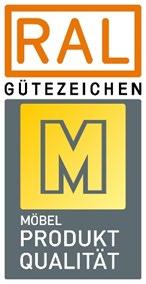
The implementation regulations of the Deutsche Gütegemeinschaft Möbel apply exclusively to the use of the quality mark.
11. Amendments
Amendments to these Quality and Testing Regulations require the prior written consent of RAL to become effective. They come into force after a reasonable period of time after they have been announced by the Executive Board.
12. Implementing Regulations for the Award and Use of the Quality Mark of the Deutsche Gütegemeinschaft Möbel e. V.
12.1. Assessment basis
The assessment basis for the quality mark consists of the Quality and Testing Regulations for Furniture. It is amended and further developed in line with technical progress.
12.2. Awarding the quality mark
11.2.1 The Deutsche Gütegemeinschaft Möbel e. V. awards the right to use the quality mark for furniture to manufacturers of quality furniture upon application.
11.2.2 The application for the award of the quality mark must be submitted in writing to the office of the Deutsche Gütegemeinschaft Möbel e. V., Friedrichstraße 13-15 in 90762 Fürth. The application must be accompanied by a list of the products which the applicant wishes to have approved for quality assurance as well as a legally binding signed certificate of commitment (Sample 1).

11.2.3 This application is reviewed by the Quality Committee. The Quality Association commissions a neutral testing institute to carry out the initial testing. The test result is sent in writing to the Quality Committee, the applicant, and the Executive Board of the Quality Association. In addition, the Quality Committee may arrange for a factory inspection to be carried out by authorised inspectors or inspectors authorised by the testing institute. The applicant shall bear the costs for this as well as the cost for the inspection of the products. The Quality Association may authorise the testing institute to request an advance payment for inspection costs.
11.2.4 If the result of the inspection is positive, the Executive Board of the Quality Association awards the quality mark to the applicant on the recommendation of the Quality Committee. The award is certified (Sample 2). If the result of the inspection is negative, the Quality Committee will defer the application. It must give reasons for the deferral in writing.
11.3.1 Users of the mark may only use the quality mark for products that comply with the Quality and Testing Regulations.
11.3.2 The Quality Association has the sole right to have marking materials of the quality mark produced for all purposes (embossing stamps, printing blocks, matrixes, seal stamps, rubber stamps, etc.) and to issue them or have them issued to the users of the quality mark or to grant permission for their production and to specify the type of application in more detail.
11.3.3 The Executive Board may issue special regulations for the use of the quality mark in advertising on brochures, offers, order confirmations and delivery bills, etc., in order to maintain fair competition and prevent misuse of the quality mark.
11.3.4 The right to use the quality mark ends in case of death, opening of insolvency proceedings, liquidation, withdrawal or if the user of the quality mark renounces the right to use the quality mark by legally signed declaration to the Managing Director by registered letter on a date determined by the user.
11.3.5 If the right to use the quality mark has been legally withdrawn, the award certificate and all means of labelling with the quality mark must be returned; there is no entitlement to reimbursement. The same applies if the right to use the quality mark has otherwise expired.
11.4.1 The Quality Association is entitled and obliged to monitor compliance with the Quality and Testing Regulations as well as the lawful and proper use of the quality mark.

11.4.2 Every user of the quality mark must take the necessary precautions to ensure that the products bearing the quality mark comply with the Quality and Testing Regulations. Careful records must be kept of the required internal quality control procedures. In addition, every user of the quality mark shall subject these products to the monitoring tests arranged by the Quality Association to the extent and frequency in accordance with the requirements of the Quality and Testing Regulations and shall bear the testing and transport costs incurred as a result.
11.4.3 The Quality Committee commissions neutral testing institutes (officially recognised material testing institutes or equivalent testing institutes) to carry out the monitoring tests and makes the necessary agreements with them.
11.4.4 Assessors authorised by the neutral testing institutes may carry out monitoring tests at the company of the quality mark user at any time without prior notification up to twice a year, inspect the records of the company's own inspections and visit the company during operating hours. Products requested by the assessor as test pieces are to be handed over immediately. The assessor is entitled to dismantle finished products during the inspection. If the test is carried out elsewhere, the test pieces must be clearly marked by the assessor immediately upon removal. Products of the quality mark user can also be taken from the trade.
11.4.5 The appointed testing institute determines the test results independently of the bodies of the Quality Association. The testing institute prepares a test report for each test, a copy of which is sent to the Quality Association and to the quality mark user in question. Further dissemination of the test result is prohibited.
11.4.6 In case of a negative test result or in case of complaints about products of the quality mark user, the Quality Committee has the test repeated.
11.4.7 In the case of inspections requested from the Quality Association by third parties, the inspection costs are borne by the complainant in the event of an unjustified complaint, and by the quality mark user in the event of a justified complaint.
11.5.1 If the Quality Committee identifies deficiencies in quality assurance, it proposes sanctioning measures to the Executive Board of the Quality Association. Depending on the severity of the violation, the Board may:
11.5.1.1 Issue an instruction and/or a warning against the user of the quality mark,
11.5.1.2 Order an increase in the number of monitoring tests to be carried out for a certain period of time,
11.5.1.3 Impose the payment of a contractual penalty depending on the extent of the breach in question, up to EUR 10,000 in favour of the Quality Association,

11.5.1.4 Withdraw the right to use the quality mark temporarily or permanently.
11.5.2 If deviations from the Quality and Testing Regulations or an infringement of the conditions of use of the quality mark are detected during inspection of the products of the quality mark user, an instruction or warning will be issued. Depending on circumstances, the latter is issued in conjunction with an ordered increase in the number of monitoring tests to be carried out and/or by the imposition of a contractual penalty. The contractual penalty is to be paid to Deutsche Gütegemeinschaft Möbel e. V. within 14 days after the decision has become legally binding.
11.5.3 The right to use the quality mark will be withdrawn temporarily or permanently if the Quality and Testing Regulations or the conditions for use of the quality mark have been repeatedly violated, or if the quality mark has been misused, or if a deliberate violation of the Quality and Testing Regulations has been proven, or if the quality mark user otherwise grossly violates the quality assurance through their conduct.
11.5.4 Should a member use the quality mark without authorisation or allow a third party to affix it to their products or permit the third party to use the quality mark in any other way, a contractual penalty of up to EUR 10,000 will be due for each individual case. Any legal action ensuing from such behaviour will not be affected by the issuing of said penalties.
11.5.5 A penalty as laid out under Section 5.1 may also be issued if the quality mark user delays or obstructs immediate monitoring tests as described under Section 4.
11.5.6 The affected party must be heard before any measures are taken. Before the right to use the quality mark is withdrawn from a quality mark user, the affected party must be given the opportunity to make a statement within a period of 4 weeks.
11.5.7 In urgent cases, the Chairman of the Quality Association may provisionally prohibit a quality mark user from using the quality mark with immediate effect. Such an order must be confirmed or rescinded by the Executive Board of the Quality Association within 14 days.
11.5.8 The duty of the Quality Association to intervene against impairment of the use of the quality mark and in the event of misuse of the quality mark also obliges the users of the quality mark under trademark law to notify the Managing Director of the Quality Association without delay of any violations of the conditions of use of the quality mark and any cases of misuse of the quality mark of which they become aware and to submit substantiating documents so that the violation can be prosecuted in an appropriate manner. Failure to do so shall be punished in accordance with Section 5.1.
11.5.9 Measures taken by the Quality Association to protect the quality mark within the meaning of these provisions shall not affect the right of quality mark users to assert

any claims for compensation for damage directly incurred by them as a result of infringement under civil law.
12.6. Objection
11.6.1 The quality mark user may lodge an appeal with the Quality Committee against a penalty notice in accordance with Section 5.1 within 4 weeks of notification of the notice. A decision on the appeal must be made within 4 weeks. The appeal has a suspensive effect; however, in the event of an acute risk of misleading the market, the Quality Committee may provisionally confirm a sanctioning measure in accordance with Section 5.1.4 even before deciding on the appeal.
11.6.2 If the objection is rejected, the complainant may take legal action in accordance with Section 11 of the Articles of Association within 4 weeks of being served with the decision rejecting the complaint.
12.7. Reinstatement of usage rights
If the right to use the quality mark has been withdrawn, it may be re-awarded after three months at the earliest. The procedure is determined in accordance with Section 2. However, the Executive Board of the Quality Association may impose additional conditions.
12.8. Amendments
These Implementing Regulations together with samples (declaration of membership, award certificate) are recognised by RAL. Amendments, including those of an editorial nature, require the prior written consent of RAL to become effective. They come into force after being announced by the Executive Board within a reasonable period determined by the Executive Board of the Quality Association.

1. The undersigned / the undersigned company hereby applies to the Deutsche Gütegemeinschaft Möbel e. V. for
admission as a member*
the award of the right to use the quality mark for furniture in conjunction with the product related addition according to Section 2 of this Certificate of Commitment.
2. The undersigned / the undersigned company confirms that they have read the Quality and Testing Regulations for Furniture in conjunction with the
Quality and Testing Regulations for Cabinet Furniture, RAL-GZ 430/1*
Quality and Testing Regulations for Kitchen and Bathroom Furniture, RAL-GZ 430/2*
Quality and Testing Regulations for Tables, Chairs and Corner Seats, RAL-GZ 430/3*
Quality and Testing Regulations for Upholstered Furniture, RAL-GZ 430/4*
Quality and Testing Regulations for Beds, RAL-GZ 430/5*
Quality and Testing Regulations for Mattresses, RAL-GZ 430/6*
Quality and Testing Regulations for Waterbeds, RAL-GZ 430/7*
Quality and Testing Regulations for Office Furniture, RAL-GZ 430/8*
Quality and Testing Regulations for Children’s Furniture, RAL-GZ 430/9*
Quality and Testing Regulations for School Furniture, RAL-GZ 430/10*
Quality and Testing Regulations for Outdoor Furniture RAL-GZ 430/11*
The Articles of Association of the Deutsche Gütegemeinschaft Möbel e. V.,
The Quality Mark Statutes for the quality mark Furniture,
The Implementing Regulations with Samples 1 and 2
and hereby recognise them without reservation as binding in themselves.
Number of employees: ...............
(Place and date)
*Please mark as appropriate
(Stamp and signature of the applicant)

On the basis of the test report submitted to the Quality Committee, the Deutsche Gütegemeinschaft Möbel e. V. hereby awards the company
Mustermann GmbH
the Quality Mark for Furniture
Which has been recognised by RAL Deutsches Institut für Gütesicherung und Kennzeichnung e. V. (RAL German Institute for Quality Assurance and Labelling) and is protected as a collective trademark through registration at the German Patent and Trademark Office in connection with the product-related addendum according to the following mark illustration
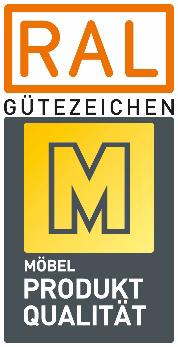
FÜRTH, 01. 01. 2022
Chairperson of the Board CEO


13.1. Transport and assembly guidelines for box furniture
Industry – Logistics – Trade
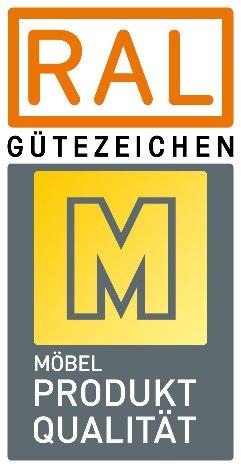
Index
Delivery vehicle
Loading (valid for industry and trade)
Unloading at the warehouse
Unloading at the end customer
Furniture assembly
Furniture, equipment and b uilding connection technology
Returns

The delivery vehicle must meet the following requirements of a transport-suited furniture delivery:
• Solid, watertight box truck
• Walls with coextensive lashing rails at 3 different heights (at least)
• Load compartment floor always well-swept, smooth, and clean
• Unloading edge rounded and in clean condition
• Equipment:
Furniture covers (in sufficient number)
Foam wedges
Lashing straps (according to DIN EN 12195-2)
Loading bars
Sack truck (rounded edges)
Airbags
The following criteria must be taken into account for loading:
• Check furniture items for damage and completeness
• Do not place furniture item on the edge/corner
• Take into account the specified stacking edge (symbol acc. to DIN EN ISO 780)
• Stack furniture items according to the rule light on heavy
• Use suitable cargo securing equipment
• For extra protection, always place furniture fronts (tall cabinets) between outer and middle sides
• Never place mirrors and glass components on the edge and always protect them with covers, cardboard, etc.
• Do not slide packages of dressers, panels and kitchen corner base cabinets when stacking, but place them correctly on top. The load must be transmitted in such a way that it is secured by the corner protection edges at the body
• Always secure kitchen corner base cabinets with a protective plate before stacking them with other packages

• Observe unloading points and commission-specific loading sequence
• When releasing the load securing devices, make sure that the furniture items do not tilt or slip
• Do not place furniture items on the corner/edge
• Observe the unloading guidelines of the trading partners
• Check furniture items for damage and completeness; obvious damage must be reported to the warehouse personnel/forwarding agency and documented in the delivery note
• After each unloading point, the remaining furniture items must be reloaded and secured (as described under Loading)
• When releasing the load securing devices, make sure that the furniture items do not tilt or slip
• Do not place furniture items on the corner/edge
• Do not remove the original packaging until you are at the installation site
• The possible disassembly of a piece of furniture to facilitate transport may only be carried out in accordance with the assembly instructions
• Any damage must be documented immediately with photos
• Assembly pursuant to the manufacturer’s specifications according to the assembly and installation instructions
• Alignment for a harmonious overall appearance
• Horizontal alignment on the floor space
• Briefing of the customer on the product, including visual inspection and functional testing
• Handing over of the product information (operating or instruction manual)
• When using electrical or battery-powered components, the manufacturer’s safety and operating instructions must be strictly observed

• Wall mounting for tilt-critical furniture
• Mount wall cabinets with fasteners that are adapted to the wall structure 1
• Special tools provided by the manufacturer for assembly and disassembly must be used
• Take into account functional and assembly dimensions
Assembly clearance – upwards, tilt angle for high parts: height dimension + approx. 2%
Mounting clearance for corner units approx. 20 mm per wall leg side, check angle in advance with protractor
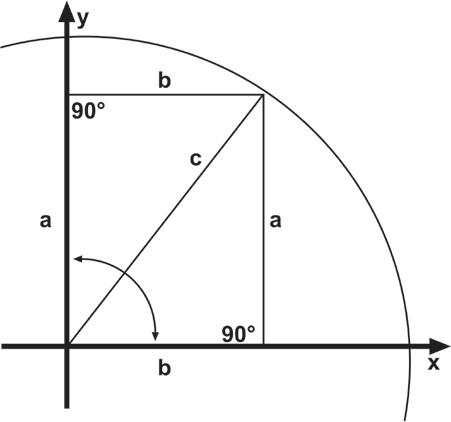
Furniture, equipment and building connection technology
All electrical connections must only be installed by trained personnel!
Technical basics
• Electrical installations in furniture according to DIN VDE 0100 Part 724
• Lighting systems in furniture according to DIN VDE 0100 Part 559
• Lights, cables, and wires according to DIN EN 60598/ VDE 0711 with quality mark
• Lights, safety transformer, converter according to DIN VDE 0710 Part 14 with labelling
• Connection and connecting element according to DIN EN 60320
1 The furniture buyer is responsible for the suitability of the building conditions for the installation and assembly of the furniture, particularly with regard to the load-bearing strength of the walls and their building moisture/wall humidity.

The furniture buyer is obligated to point out construction- related conditions and obstacles! If obstacles are not indicated in the purchase contract, the assembler has the duty of care to check the following details before assembly, which inhibit , restrict, or possibly exclude correct assembly.
The basis for the test is an electronic construction and cable finder for:
• Electrical lines
• Water/drainpipes
• Heating pipes – wall and floor heating
• Communication/TV connections
• Gas connections
When connecting extractor hoods, open fireplaces must be taken into account. An additional circuit with a tilt switch to the window is necessary here to ensure a sufficient amount of air in the room.
Installation may only be carried out by qualified personnel.
• Network and antenna connection behind/above media elements
• Euro socket strip with overvoltage for equipment connection technology
• Separation of current- and signal-carrying cable connections
• Wall mountings: check of wall condition required
• Mounting position can be seen in the planning height according to the drawing – cable outlet centred behind the rear panel
• For wall shelves 300 mm from outer edges
• Installation or attachment with network connection (fixed connection only by qualified electrician)
• Separate circuits are possible on request
• Control via foot-, radio-, dimmer- or IR- switch
• Cable connections “on wall plaster” with paintable cable duct
• Cable connection “below wall plaster” with empty conduit Ø 20 mm

Building connection
Installation position of electrical components to network connection only as instructed by the manufacturer.
Electrical or fixed sanitary connection only by skilled electrician or sanitary expert
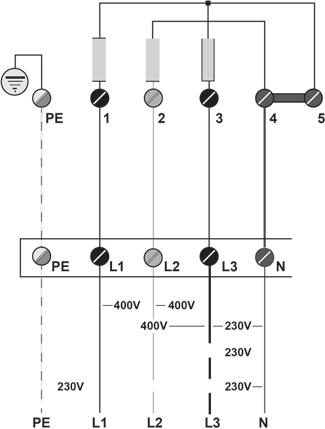
Caution – induction current
Always mask cable routing separately – if possible, do not lay cables crosswise so that a negative induction current reaction can be ruled out.
Safety and warning instructions
• Disconnect the power during assembly, cleaning, or servicing of electrical equipment.
• Small children should not be able to reach or operate electrical equipment.
• Electrical equipment must not be covered or hung up (heat accumulation or danger of overheating).
• Spare parts may only be replaced if they are of the same type and have the same amperage and voltage
Returns
“Returns are to be treated as new goods (possibly already customer property)”
• If possible, the goods should be packed already in the customer’s home (but at the latest on the truck)

• The goods must be packed in such a way that further additional, subsequent damage is avoided (with bubble wrap and edge protection if possible).
• Further additional damage must be reported immediately to your customer service.
• The goods must be declared in such a way that proper “internal control” can take place (e. g. return for factory rework).
• The goods must be handled with even more care than new goods during the entire transport route.
• The goods must be taken to their designated storage position and stored in such a way that no further damage is caused.
• If the goods are forwarded (e. g. by forwarding agency to industry), it must be ensured that they are ready in time for the notified date (if necessary, the driver – including the forwarding agent - m ust be asked to take the returned goods with him).

13.2. Transport and assembly guidelines for upholstered furniture
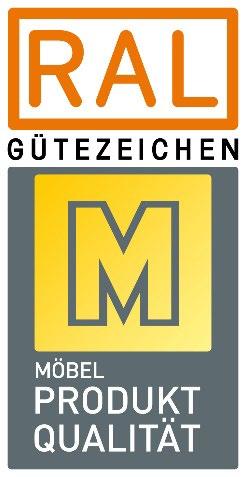
Index
Delivery vehicle
Loading (valid for industry and trade)
Unloading at the warehouse
Unloading at the end customer
Furniture assembly
Returns

The delivery vehicle must meet the following requirements of a transport-suited furniture delivery:
• Solid, watertight box truck
• Walls with coextensive lashing rails at 3 different heights (at least)
• Load compartment floor always well-swept, smooth, and clean
• Unloading edge rounded and in clean condition
• Equipment:
– Furniture covers (in sufficient number)
– Foam wedges
– Lashing straps (according to DIN EN 12195-2)
– Loading bars
– Sack truck (rounded edges)
– Airbags
The following criteria must be taken into account for loading:
• Check furniture items for damage and completeness
• Do not place furniture item on the edge/corner
• Take into account the specified stacking edge (symbol acc. to DIN EN ISO 780)
• Stack furniture items according to the rule light on heavy
• Use suitable cargo securing equipment
• Avoid creating pressure points when using lashing straps/loading bars
• Observe unloading points and commission-specific loading sequence
• When releasing the load securing devices, make sure that the furniture items do not tilt or slip
• Do not place furniture items on the corner/edge
• Observe the unloading guidelines of the trading partners

• Check furniture items for damage and completeness; obvious damage must be reported to the warehouse personnel/forwarding agency and documented in the delivery note
• After each unloading point, the remaining furniture items must be reloaded and secured (as described under Loading)
Unloading at the end customer
• When releasing the load securing devices, make sure that the furniture items do not tilt or slip
• Do not place furniture items on the corner/edge
• Do not remove the original packaging until you are at the installation site
• The possible disassembly of a piece of furniture to facilitate transport may only be carried out in accordance with the assembly instructions
• Any damage must be documented immediately with photos
Furniture assembly
• Assembly pursuant to the manufacturer’s specifications according to the assembly and installation instructions
• Alignment for a harmonious overall appearance
• Horizontal alignment on the floor space
• Briefing of the customer on the product, including visual inspection and functional testing
• Handing over of the product information (operating or instruction manual)
• When using electrical or battery-powered components, the manufacturer’s safety and operating instructions must be strictly observed
• Special tools provided by the manufacturer for assembly and disassembly must be used
Returns
“Returns are to be treated as new goods (possibly already customer property)”
• If possible, the goods should be packed already in the customer’s home (but at the latest on the truck).
• The goods must be packed in such a way that further additional, subsequent damage is avoided (with bubble wrap and edge protection if possible).
• Further additional damage must be reported immediately to your customer service.

• The goods must be declared in such a way that proper “internal control” can take place (e. g. return for factory rework).
• The goods must be handled with even more care than new goods during the entire transport route.
• The goods must be taken into their designated storage position and stored in such a way that no further damage is caused.
• If the goods are forwarded (e. g. by forwarding agency to industry), it must be ensured that they are ready in time for the notified date (if necessary, the driver – including the forwarding agent - m ust be asked to take the returned goods with him).

Name, address
Commision no./ purchase agreement no. :
Room dimensions (please provide a sketch) : room height, width, depth, angle, wall projection, door width, etc.Unobstructed access on the day of delivery is possible (wide doors, staircase) yes □ no □
Base height:___________ cm
Working height:___________ cm
Window height:____________ cm
Balustrade height (upper edge of windowsill): ___________ cm Tall cabinet height (without cornice) ___________ cm
Required door dimension for corner cabinets: ___________ cm
Information on parking possibility for delivery vehicle )e.g. distance to customer: _________________________________________
Note for large capacity furniture (dimensions, weight, disassembly possibilities): __________________________________________
The following points must be observed: Yes No
Worktop with excess depth cm
Incorporate worktop into window
Incorporate windowsill into worktop
Raised skirting board required – uneven floor
Equipment skirting required (at 91 cm working height)
Are cutouts to be worked in?
Are the fittings and wall properties adapted to subsequent loads?
Can a test drilling be carried out by the experts if necessary?
Are there pipes behind the cabinets?
Do exposed pipes have to be covered?
Is a depth fitting required for the tile bed?
Will the customer’s own equipment be installed?
Separate workshop order has been completed
Is additional body material required?
Repositioning of a therme
Installation of a hot water tank (prepare sketch if necessary)
Install installation connections according to measurement
Sketch for water and wastewater pipes prepared
Installation plan for electrical connections available
□ Natural gas □ City gas □ Liquid gas
Sketch for gas connection available
Existing connections are used (see drawing)
Note on possible consequential damage in case of wall moisture orinsufficient wall insulation due to constructional reasons
If a measurement cannot yet be taken for structural reasons or if the customer does not want a measurement, the customer is liable for the correctness of the specified dimensions and bears all costs for any necessary modifications. Any subsequent measurement or non measurement may result in a delivery delay. The customer is responsible for this delay as well as for the costs of any necessary rescheduling or new and repeat orders. Built-in sinks and electrical appliances are not connected. Place, date Signature of sales personnel/measurer Customer’s signature
Acceptance report for delivery at …………………..… Customer: ……………………………………
Order no. ………………………………….
For furniture delivery / assembly Y / N
Have all parts been assembled completely and in balance?
Were the functions of the movable parts demonstrated and explained?
Are the surfaces flawless?
Was the furniture correctly aligned?
Are the upholstery/covers in good order?
Was the workplace left clean?
Was the packaging taken back?
Are there any reasons for a complaint?
Reason for complaint:
Item:
Defects:
Sales error Assembly error Supplier’s fault
Additionally for kitchen assembly Y / N
Have built-in appliances been checked for function and explained?
Were cabinets, doors, flaps, and drawers functionally and neatly aligned?
Was the water installation checked for leaks?
Were care instructions provided f or the counter tops?
Were moisture issues in the dishwasher and in mitre areas addressed?
Are the operating instructions for appliances available?
Was customer property damaged (walls; floors…)?
Were any missing parts or damage noted i n the delivery note?
Notes:
Invoice amount of the rejected item:
Reasonable retention:
Date
Customer’s signature Technician’s signature


Date - time:
Name - Furniture store and clerk:
Name - Model – Execution – Commission:
Order confirmation number – Delivery from:
Description of damage:
1. Was the packaging already damaged when handed over by the shipping company?
Yes □ No □
When was the damage reported?
2. When/how was the damage detected?
Date: ………………………………………
During receipt of goods During loading During assembly
Approx. …… day/s after assembly by the end customer In use since ........................
3. Brief description of the “defect type” of the complaint:
□ Compression mark (dent) □ Fracture/ breakthrough
□ Scratch (transverse – longitudinal - diagonal)
□ Compression (edge – surface) □ not functional
4. Brief description of defect – please mark location (if possible with digital photo, possibly use folding rule for size estimation):
Body (exterior)
Ancillary
Body (interior) Console
Outside right/left
Back panels
Doors/front
Outside drawers
Drawer front
Dresser
Armchair
Sofa
Functional part
Electrical part

13.6. Guideline for electrical equipment / components in furniture
For all employees from the areas of Purchasing – Construction – Quality assurance
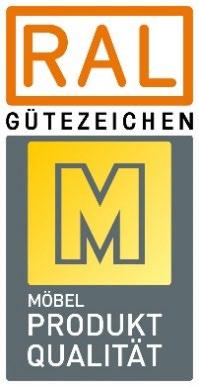
Index
General remarks
Labelling in accordance with the Product Safety Act (ProdSG)
Directives
Significant product changes
Combination of components
Requirements for different product groups
General classification of devices and modules according to the Low Voltage Directive or the Machinery Directive
Abbreviations and their meaning
Installation in furniture

General remarks
Aim:
This guideline provides an overview of the essential standards and technical rules to be taken into consideration where statutory regulations on product safety and product labelling in the European Economic Area are concerned.
General instructions for purchasing:
1. The supplier must submit precise product-specific test certificates on product safety in accordance with the relevant EU directives. Declarations of conformity alone or only the cover page of certificates are not sufficient for manufacturer liability. It must be ensured that the test reports or test certificates are up to date.
2. A release from liability with the pre-supplier must be contractually stipulated
3. The system requirements for the respective area of application must already be contractually specified when the order is placed.
4. The requirements for the individual destination countries with regard to labelling and normative requirements are to be listed and requested with the order.
Note on the specification of standards:
If no date of issue is given for standards or guidelines, the current version applies. Special attention must be paid to any transitional periods.
The Low Voltage Directive is to be considered only for certain nominal voltages of a device:
For DC voltage: 75 to 1500 Volt
For AC voltage: 50 to 1000 Volt
For electrified furniture that has a connection to the main network, the Low Voltage Directive applies in all cases.
Disclaimer: These guidelines are intended as a guide and make no claim to completeness. In individual cases, it is also necessary to check which requirements must be met in accordance with the relevant legal regulations. No liability can be assumed for individual cases.
Labelling according to the Product Safety Act (ProdSG of 8 November 2011)
Consumer products must generally be labelled according to Section 6 of the Product Safety Act with:

- Name and contact address of the manufacturer
- Clear labelling for identification of the consumer product
If the manufacturer is based outside the European Economic Area, some obligations are transferred to the importer. For example, the importer must ensure that a European address is provided and that the technical documentation for the product is available or prepared.
If products are manufactured outside the EU but sold under the name of a European ( trading) company (OEM business), then the European company becomes a quasi-manufacturer and must fulfil all the obligations of a manufacturer (including the issuance of the declaration of conformity).
Liability risks: Incorrect and misleading labelling of products may give rise to regulatory or competition law liability risks. In the event of a hazard, regulatory authorities may order product recalls. Likewise, in the event of liability, insurance law problems may arise in the event of gross negligence, which may even lead to the loss of insurance coverage.
A product must bear the CE label if the product falls within the scope of at least one EC Directive that requires this label.
The “CE Directives” are usually all equally valid. If a product falls within the scope of several directives, then all of them must be observed (e. g. Low Voltage Directive and EMC Directive). In the declaration of conformity, several directives must be mentioned accordingly (or several declarations of conformity must be issued).
Exceptions:
If a product falls within the scope of the Machinery Directive and the Low Voltage Directive, then formally only the Machinery Directive applies to the declaration of conformity. However, the technical safety requirements of the Low Voltage Directive, which is mentioned as a cross-reference in the Machinery Directive, must be fulfilled.
If a product falls within the scope of the RED Directive, then the EMC Directive and the Low Voltage Directive formally fall away in the declaration of conformity. However, the RED Directive itself contains cross-references to the technical requirements of the EMC Directive and the Low Voltage Directive.
In the case of furniture that falls under the Electrical and Electronic Equipment Act (ElektroG), appropriate labelling must be applied to the furniture and the method of disposal must be indicated in the operating instructions.

In the case of declarations of conformity in accordance with EC Directives based on internal manufacturing controls, special technical instruction may be required for employees in manufacturing who install electrical components or manufacture machines.
The existing conformity assessment documents (and thus also the declaration of conformity and the CE labelling) always apply only to the product in the condition in which the assessment was made.
If a product is substantially changed, e. g. by a processing company, then the person who makes these changes becomes the manufacturer of a new product and must carry out a new conformity assessment (including declaration of conformity and labelling).
Such changes may include operative changes to the product itself, but also changes to the environmental conditions intended by the original manufacturer:
Example: Installation of a device actually intended for desktop operation in a closed housing (=> problems with heat dissipation). Commercially available AV/IT devices, for example, are usually not designed for complete integration, but for free-standing installation with sufficient air space for cooling around the device
When combining components into a final product (e. g. wiring of multiple ballasts, connecting cables and lamps), it CANNOT be assumed that the complete product automatically meets the requirements of all directives if the individual components are CE marked individually:
- In some cases, the combination results in new requirements.
- The combination may cause limit values to be exceeded that are still met individually
13.6.1.
13.6.1.1.
Complete luminaires
Installation and mounting variants
Normative and legal requirements
Standard series EN 60598 (Luminaires):
DIN EN 60598-1 General requirements
EN 60598-2-1 Fixed luminaires
DIN EN 60598-2-2 Recessed luminaires
DIN 57710-14 (MM marking; national standard, withdrawn)

Red Directive 2014/53/EU (only if radio interface exists)
ErP Directive – Energy consumption
Directive 2009/125/EC
Regulation 2019/2020 Establishment of ecodesign requirements for light sources and separate operating devices
Regulation 2019/2015 Energy consumption labelling of light sources
Recycling RoHS and WEEE Directives
2011/65/EC (RoHS)
2012/19/EU (WEEE) only for certain luminaires/lamp types
Electrical and Electronic Equipment Act
Performance / Lifetime Applicable standards, for example:
DIN EN 60929 Performance ballasts for fluorescent lamps (only applies to tubular fluorescent lamps)
DIN EN IEC 62384 Performance LED ballasts
Control / Remote control
13.6.1.2.
Direct integration
Audio / Video and IT devices
For example:
DIN EN IEC 61347-2-11 Electronic modules for lamps (Twilight or proximity switch modules installed in luminaires)
DIN EN 61058-1 Device switch – General requirements
Standard and legal requirements
DIN EN 60065 (Audio/video devices) Safety requirements
DIN EN 60950-1 (IT devices) Safety requirements
DIN EN IEC 62368 (IT devices) Safety requirements
Labelling including declaration of conformity
CE labelling and declaration of conformity
Test records and conformity documents
- Declaration of conformity
- Test reports for the individual standards
- Private test marks/certificates
- GS label with associated certificate
Safety
Low Voltage Directive 2014/35/EU; Product Safety Directive 2001/95/EC;
Control / Remote control

Instructions for use
Product Safety Act (ProdSG)
Requirements from directives and standards (e. g. DIN EN 82079)
EMC – Electromagnetic compatibility
EMC Directive 2014/30/EU
DIN EN 55013 (A/V Emitted interference)
DIN EN 55020 (A/V Interference immunity)
DIN EN 50561-1 (IT radio disturbance)
DIN EN 55024 (IT interference immunity)
DIN EN IEC 61000-3-2 Harmonic currents
DIN EN 61000-3-3 Voltage changes / fluctuations
RED Directive
2014/53/EU (Only relevant for devices with radio interface or connection to the telephone network; devices used only for the reception of public radio and television broadcasts are exempt from the RED )
The standards are very diverse and depend on the frequency range and interface parameters => individual clarification required
ErP Directive – Energy consumption
ErP Directive 2009/125/EC
Regulation 1275/2008 (Stand-by consumption)
Regulation 642/2009 Ecodesign requirements for televisions
Regulation 1062/2010 Energy labelling for televisions
Regulation 107/2009 Ecodesign requirements for simple set-top boxes
Regulation 278/2009 Power consumption of external power supplies
Regulation 617/2013 Ecodesign for PCs
Regulation 801/2013 Ecodesign for televisions
Recycling RoHS and WEEE Directives
RoHS Directive 2011/65/EU
WEEE Directive 2012/19/EU
The requirements are essentially included in the aforementioned directives/standards.
13.6.1.3.
Normative and legal requirements
Standard series EN 60335 (General part and relevant special part)

Direct integration
Domestic Appliances
DIN EN 60335-1 General requirements for all appliances
DIN EN 60335-2-5 Dishwasher
DIN EN 60335-2-6 Stoves, (built-in) ovens, hobs, steam cookers
DIN EN 60335-2-14 Kitchen appliances (e. g. all-purpose slicer)
DIN EN 60335-2-24 Cooling devices
DIN EN 60335-2-25 Microwave ovens
DIN EN 60335-2-31 Range hoods
DIN EN 62233 Electromagnetic fields with regard to safety
Labelling including declarations of conformity
CE label and declaration of conformity
Test records and conformity documents
- Declaration of conformity
- Test reports for the individual standards
- Private test marks/certificates
- GS label with associated certificate
Safety
Low Voltage Directives: 2014/35/EU;
Product Safety Directive (2001/95/EC); Machinery Directive (2006/42/EC)
Instructions for use
Product Safety Act (ProdSG)
Requirements from directives and standards
EMC – Electromagnetic compatibility
EMC Directive 2014/30/EU
DIN EN 55014-1 Emitted interference
DIN EN 55011 (only for microwave ovens and induction; instead of EN 55014-1)
EN 55014-2 Interference immunity
DIN EN IEC 61000-3-2 Harmonic currents
DIN EN 61000-3-3 Voltage changes / fluctuations
(Higher interference immunity requirements apply if products are used commercially in industrial environments.)
RED Directive
(Only relevant for devices with radio interface or connection to the telephone network)
Control / Remote control
13.6.1.4.
Motorised drive gears
ErP Directive – Energy consumption
ErP Directive 2009/125/EC
Regulation 1275/2008 Stand-by consumption
Regulation 643/2009 Ecodesign requirements for cooling devices
Regulation 278/2009 Power consumption of external power supplies
Regulation 1016/2010 Ecodesign requirements for dishwashers

Energy-labelling requirements for ovens, refrigerators, and dishwashers
Recycling RoHS and WEEE Directives
RoHS Directive 2011/65/EU
WEEE Directive 2012/19/EU
Requirements for remote-controlled devices are partly already included in the DIN EN 60335 series.
Normative and legal requirements
DIN EN 60335-1 General requirements
(DIN EN 60335-2-103, DIN 18650-1); as well as other product-related requirements of the standard series DIN EN 60335
DIN EN ISO 13849 for functional safety in control systems
DIN EN 62233 Electromagnetic fields with regard to safety
Labelling including declaration of conformity
Depending on the type
(Component, partly-completed machine, complete machine)
Test records and conformity documents
- Declaration of conformity
- Installation instructions in accordance with Machinery Directive
- Test reports for the individual standards
- Private test labels/certificates
- Risk assessments
Safety
Usually Machinery Directive (2006/42/EC) and applicable EU directives, e. g. Low Voltage Directive
Instructions for use / Operating instructions
Yes, plus assembly instructions

EMC – Electromagnetic compatibility
EMC Directive 2014/30/EU
DIN EN 55014-1 Household purposes
DIN EN 55014-2 Interference immunity
DIN EN IEC 61000-3-2 Harmonic currents
DIN EN 61000-3-3 Voltage changes / fluctuations or
DIN EN IEC 61000-6-2 / -3 (universal application also in commercial/industrial environment)
RED Directive
Directive 2014/53/EU (Only relevant for devices with radio interface or connection to the telephone network)
ErP Directive – Energy consumption
ErP Directive 2009/125/EC
Currently, no relevant implementing regulation exists.
Recycling RoHS and WEEE Directives
RoHS Directive 2011/65/EU
WEEE Directive 2012/19/EU
13.6.2. General classification of devices and modules according to the Low Voltage Directive1) or the Machinery Directive2)
(Other directives are not considered in this note but may apply beyond it.)
Electromechanical drives for furniture must first be assigned to the Low Voltage Directive. Within the framework of the conformity assessment procedure according to the Machinery Directive2), the drives are to be differentiated, on the one hand, according to the “intended use” defined by the manufacturer and, on the other hand, according to the comprehensiveness of the delivery condition (“Does it fulfil the intended function without further ado or not?”).
The dependent accessories required for the drive, e. g. power supply units, controls, etc., which are purchased in direct connection with the drive and do not contain any moving components of their own, are also subject to the Low Voltage Directive.
Further documentation can be agreed between the customer and the manufacturer. All cited standards must correspond to the valid dates of the EU Official Journals if they may be used for conformity assessment.
LVD1)
General principles:

Test records and conformity documents for safety (LVD1))
EMC Directive3)
– Electromagnetic compatibility
RED Directive 2014/53/EU4
Ecodesign Directive5) (ErP)
External power supplies
Normative requirements
e. g. EN 15338, RAL-GZ 430/1-2, DIN EN 4749, EN 60335-1, EN 62233 [EMF], EN 60335-2-103
Depending on the type of furniture, applicable EN standards for mechanical safety
EN 55014-1 (Household use)
EN 55014-2
EN IEC 61000-3-2
EN 61000-3-3 or
EN IEC 61000-6-2 / -3
Only relevant for devices with radio interface or connection to the telephone network
External AC/DC power supplies
Average efficiency:
If 1.0 W ≤ PO ≤ 51.0 W then 0.090 · ln(PO) + 0.500 shall apply if PO > 51.0 W then 0.850 shall apply
For no-load (idling)
PO ≤ 51.0 W 0.30 W PO > 51.0 W 0.50 W shall apply
PO = Power output according to nameplate
RoHS Directive6)
- Limitation of hazardous substances
WEEE Directive7)
- Take-back / recycling/ disposal
RoHS conformity of the drives must be demanded (as of 2013 usually by declaration of conformity).
WEEE specifics for the disposal and recycling of furniture with integrated electromechanical drives do not exist at the time of writing these notes.
Private & commercial use
CE label, assembly and operating/user instructions

13.6.3. Abbreviations and their meaning
1) LVD (Low Voltage Directive)
DIRECTIVE 2014/35/EU OF THE EUROPEAN PARLIAMENT AND OF THE COUNCIL of 26 February 2014 on the harmonisation of the laws of Member States relating to electrical equipment designed for use within certain voltage limits. Scope of application: DC voltage: 75 to 1500 Volt, AC voltage: 50 to1000 Volt
2) Machinery Directive
DIRECTIVE 2006/42/EC OF THE EUROPEAN PARLIAMENT AND OF THE COUNCIL of 17 May 2006 on machinery and amending Directive 95/16/EC (recast)
3) EMC Directive
DIRECTIVE 2014/30/EU OF THE EUROPEAN PARLIAMENT AND OF THE COUNCIL of 26 February 2014 on the approximation of the laws of the Member States relating to electromagnetic compatibility and repealing Directive 89/336/EEC
4) RED Directive 2014/53/EU DIRECTIVE OF THE EUROPEAN PARLIAMENT AND OF THE COUNCIL of 05 June 2018 on radio equipment and telecommunications terminal equipment and the mutual recognition of their conformity
5) Ecodesign Directive
DIRECTIVE 2009/125/EC OF THE EUROPEAN PARLIAMENT AND OF THE COUNCIL of 21 October 2009 establishing a framework for the setting of ecodesign requirements for energy-related products (recast) together with COMMISSION REGULATION (EC) No 278/2009 of 6 April 2009 implementing Directive 2005/32/EC of the European Parliament and of the Council with regard to ecodesign requirements for the no-load power consumption of external power supplies and their average operating efficiency
6) RoHS Directive
DIRECTIVE 2011/65/EU OF THE EUROPEAN PARLIAMENT AND OF THE COUNCIL of 08 June 2011 on the restriction of the use of certain hazardous substances in electrical and electronic equipment (recast)
7) WEEE Directive
DIRECTIVE 2012/19/EU OF THE EUROPEAN PARLIAMENT AND OF THE COUNCIL of 04 July 2012 on waste electrical and electronic equipment (WEEE)

All the EU Directives cited have been transposed into national laws.
13.6.4.
Installation in furniture
Cabling / Connections / Sockets
Normative and legal requirements
- VDE 0620-101 “Euro plug” bipolar up to 2.5 A; usable in almost all of Europe (except Ireland / Great Britain)
- DIN VDE 0620-1 Plugs and sockets, extension cords, multiple socket strips for Germany (There are different national requirements for plugs and sockets)
- EN 60320 Device connectors (to be operated by laymen);
- EN 60799 Device connecting cables
Installation regulations (national in Germany):
VDE 0100 Part 713 (Electric installation in furniture)
VDE 0100 Part 701 (Electric installation in rooms with bathtub or shower)
Labelling including declaration of conformity
CE label for complete extension cords
No CE for individual plugs according to national standards
Test records and conformity documents
- Declaration of conformity
- Test reports for the individual standards
- Private test label/certificates
- GS mark with appropriate certificate (only for ready-to-use products, e. g. extension cords)
Safety
Low Voltage Directive (2014/35/EU), Product Safety Directive (2001/95/EC), Machinery Directive (2006/42/EC);
Product Safety Act (ProdSG): Implementation of the Directives 2001/95/EC and 2014/35/EU.
Note: The individual plugs/sockets of the national mains systems in the household sector (e. g. Schuko) do not fall within the scope of the Low Voltage Directive (the General Product Safety Directive applies here). However, complete extension cords and multiple socket strips with these plug systems do fall within the scope of the Low Voltage Directive.
Instructions for use
Product Safety Act (ProdSG)

Requirements from directives and standards
Note: It is recommended to differentiate in the scope of application for consumers or professionals during assembly.
EMC – Electromagnetic Compatibility
Not relevant if EMC passive
ErP Directive – Energy consumption
Not relevant
Recycling RoHS and WEEE Directives
RoHS Directive 2011/65/EU
WEEE Directive 2012/19/EU
Further information for the installation in furniture:
Subsequent guidelines from the Gesamtverband der Deutschen Versicherungswirtschaft e. V. (German Insurance Association) can be found at: http://www.vds-industrial.de/service/suche/
Available only in German:
VdS 2324:
Richtlinien zur Schadenverhütung/ Guidelines for loss prevention (Niedervoltbeleuchtungsanlagen und –systeme / Low voltage lighting equipment and systems)
VdS 2024:
Unverbindliche Richtlinien zur Schadenverhütung / Non-binding guidelines for loss prevention Errichtung elektrischer Anlagen in Möbeln und ähnlichen Einrichtungsgegenständen / Erection of electrical installations in furniture and similar furnishings

Upholstered furniture is soft and formable. To maintain the furniture’s usage properties and quality, maintenance care is indispensable.
The following measures should therefore be carried out regularly to maintain the furniture’s value:
Regular use will leave traces on the upholstery, such as seat imprints, shifted seams and rippling on the used surfaces. By fluffing up the cushions/upholstery, upholstered furniture quickly regains its desired shape and appearance.
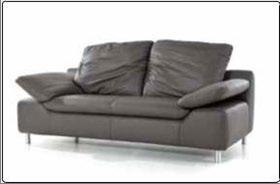
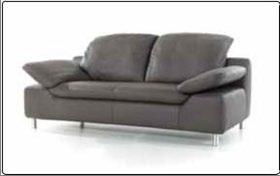

Hold the back cushion firmly with one hand in the back and fluff the cushion using the other hand. .
Fluff the back cushion with both hands at the same time, thereby distributing the filling evenly.
Subsequent to the back cushion, fluff the armrest cushions in the same way.
Maintenance care is particularly important for furniture with this type of upholstery (quilted mats, loose filling material, functions, etc.). This furniture already has a certain wavy appearance at the time of delivery. In most cases, high-quality chamber cushions are incorporated in the seat and/or back. The filling material is held in chambers within the cushions so that it does not shift. Depending on the type and thickness of the cover material,

both the chambers and the filling material will sometimes show more and sometimes less. By fluffing up the cushion after use, the compression of the cushion filling can be largely reversed.
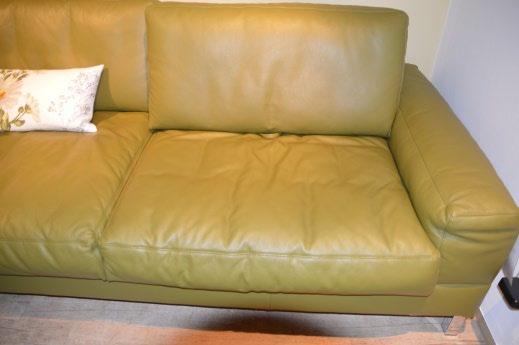
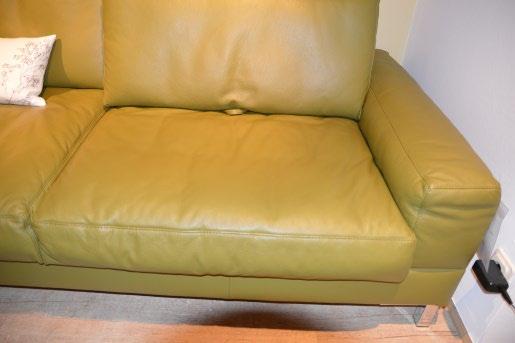
These depend on use and are unavoidable. By gently pulling and aligning the cover, any seam offsets and/or height differences can be adjusted.
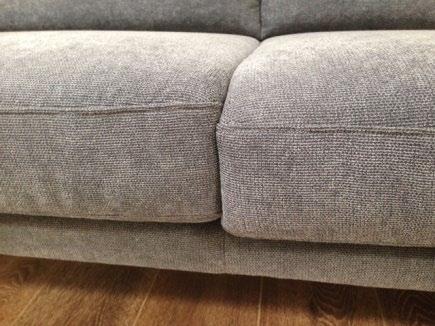
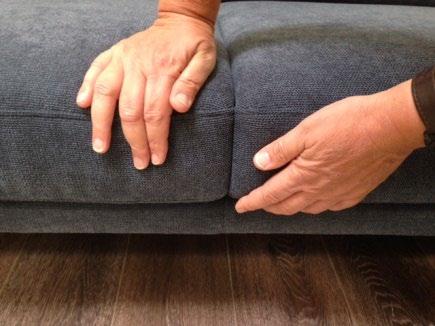
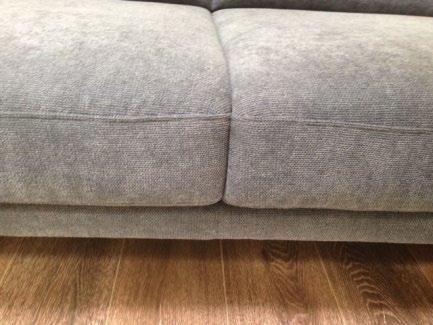
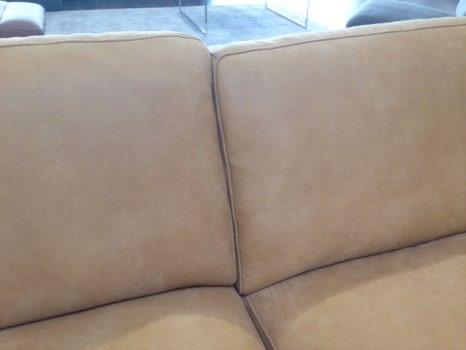
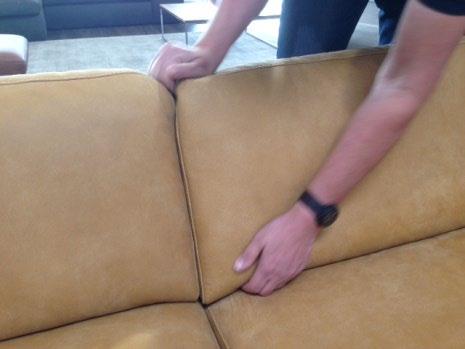

General information
Functional elements:
Always return the functional elements (footrests, headrests, etc.) to their original position after use so that no compression in the foam or visible marks form on the cover.
When using one of the functional elements, metal abrasion may occur, which should be removed regularly by wiping or vacuuming (depending on the floor covering).
Construction elements:
Mounted feet that can become loose during use should be aligned and tightened occasionally. Wear parts such as felt gliders should be replaced in time before they wear out.
cleaning
Fabric covers:
Regular brushing with a soft natural brush prolongs the life of the covers. Careful vacuuming with a vacuum cleaner is also recommended.
Leather covers:
Leather covers should be dusted once a week. Then wipe large areas with a damp cloth (Note: use only distilled or boiled water and do not use microfibre cloths or sponges).
Wood:
Varnished and waxed surfaces should be cleaned and maintained with a slightly damp leather cloth. The surfaces must be protected from hot objects.
Metal:
Metal surfaces should be cleaned and cared for with a damp cloth and detergent. Then polish with a dry, soft cloth.
Special cleaning agents are commercially available for polished surfaces.
General rule:
Liquids should always be removed immediately by dabbing.
Solvents and scouring agents should not be used.
Specific instructions from the manufacturer, e. g. cleaning and care instructions, must always be followed as a matter of priority.

13.7. Assessment of ripple formation on seating surfaces
A ripple is a deformation that deviates from the original cushion surface. A fold is a ripple with a crease.
Casual upholstered seating surfaces have a tendency to ripple in use. Ripples occur because of the main tensioning direction of the upholstery – from front to back – transverse to the tensioning direction. Such ripples are typical for casual upholstery.
Further causes for the formation of ripples in covers can be material stretching of the covers, punctual loads, too large cuts, weakening upholstery materials. etc.
Ripples in seating surfaces are permissible if the largest ripple, related to a seat width of 700 mm, is max. 20 mm high. The seat width is to be measured from seam to seam. If the seat width is interrupted by dividing seams, these are not to be taken into account for the evaluation of the seat width for the measurement. The following table serves as a guideline for the assessment of ripples on the seating surface of an upholstered piece of furniture. The ripple measurement is carried out by means of a ripple measuring device (aid), which is placed over the ripple created after the cover has been folded.
At the beginning of the test, the cover is to be smoothed and a seat test is to be carried out. After standing up, without pulling the side edges inwards, the cover is smoothed together from both sides towards the middle of the seat width. The height of the resulting largest ripple is measured.
The measuring device must not be pressed into the upholstery.
This procedure must not be followed for particularly casual models where the cover cut has been kept somewhat larger for design reasons or where the upholstery construction has been made with softer materials (e. g. down covers, especially fine padding, mat covers, belt underspringing, etc.). In this case, the ripple formation can be more pronounced without a justified complaint.
The testing and assessment method is to be applied equally to furniture leather and furniture fabrics.
Ripple / fold formation
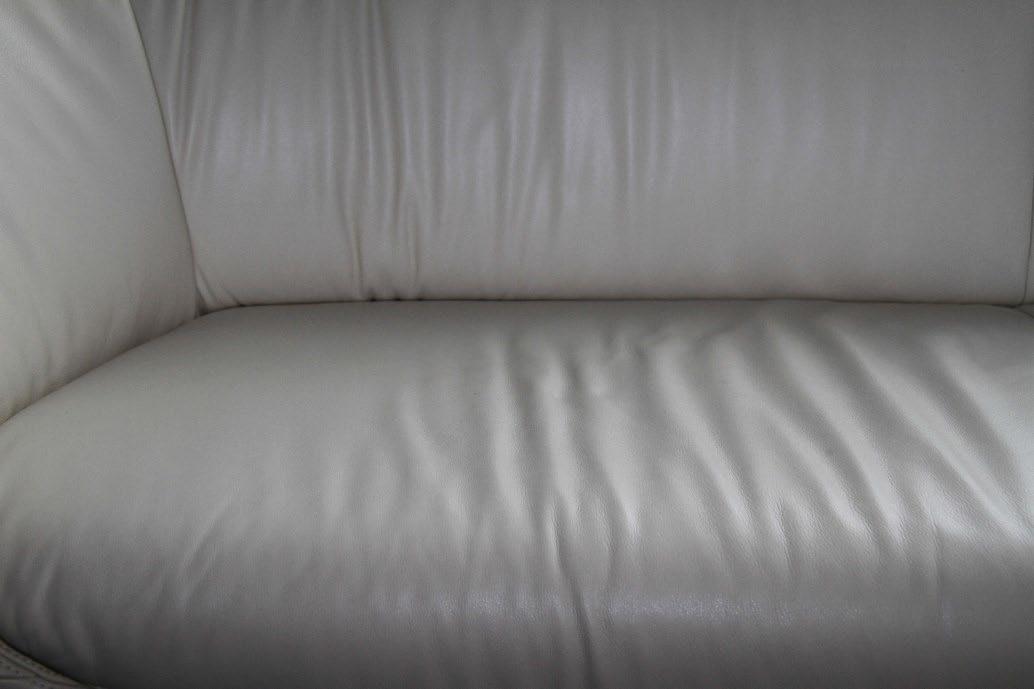
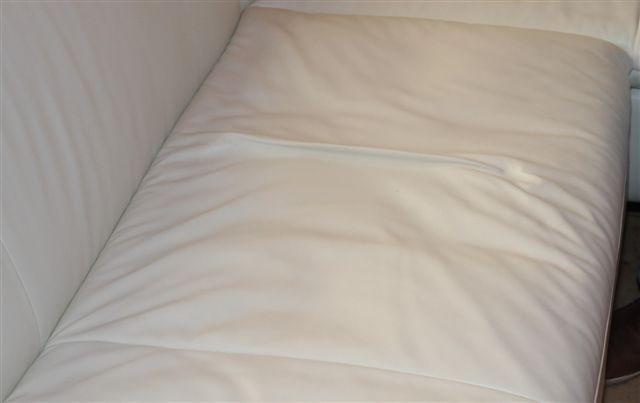

Readout line

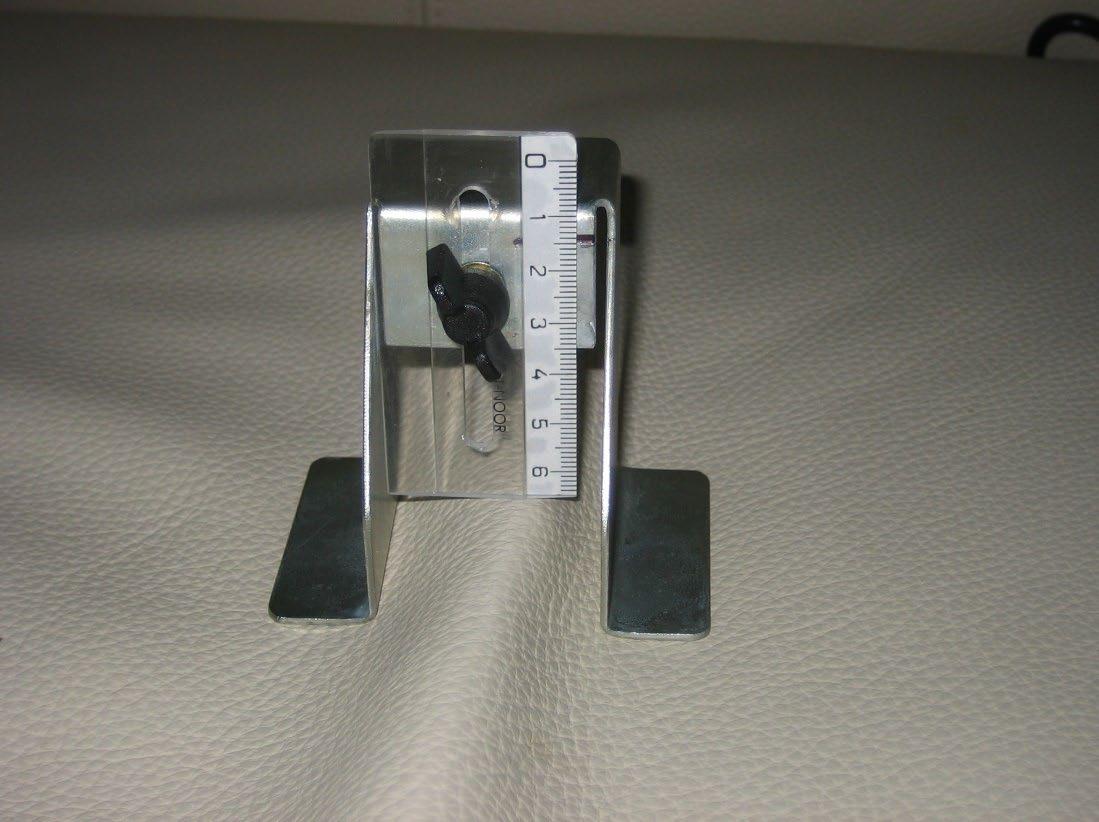
Execution
Before the test, the cover shall be smoothed, and a seat test performed.
After standing up, without pulling the side edges inwards, the cover is smoothed together from both sides towards the centre of the seat width. The height of the resulting largest ripple is measured. The measuring device must not be pressed into the upholstery.
Assessment
Ripples are permissible if the largest ripple, related to a seat width of 700 mm, is max. 20 mm high. In case of deviating seat widths (700 mm), the values must be converted accordingly. For corner elements, the seat surface is measured at the point with the largest seat width. This test method is to be used for both furniture leather and furniture fabrics equally.

Casual upholstery
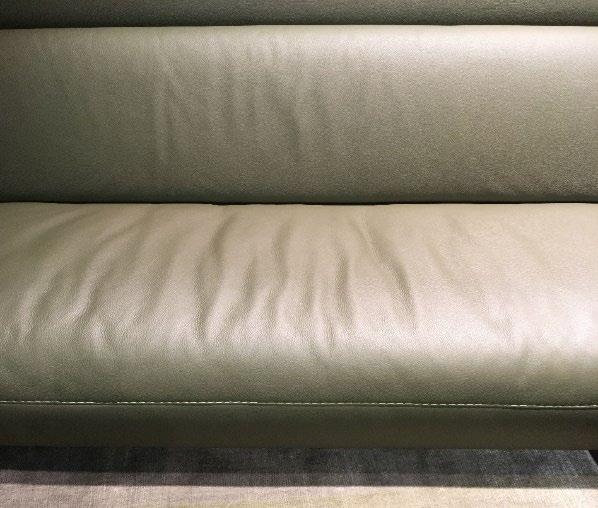
Casual upholstery – seat imprint
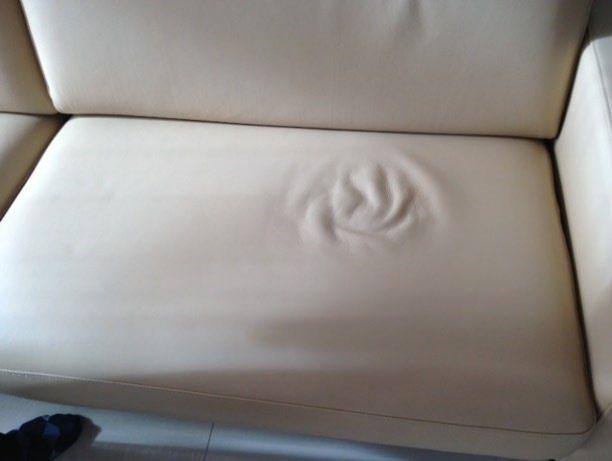
Design-intended ripple formation
Particularly casual upholstery
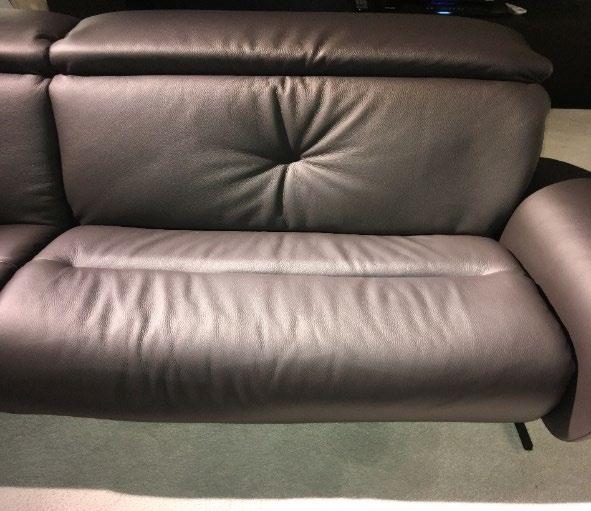
Functional upholstery
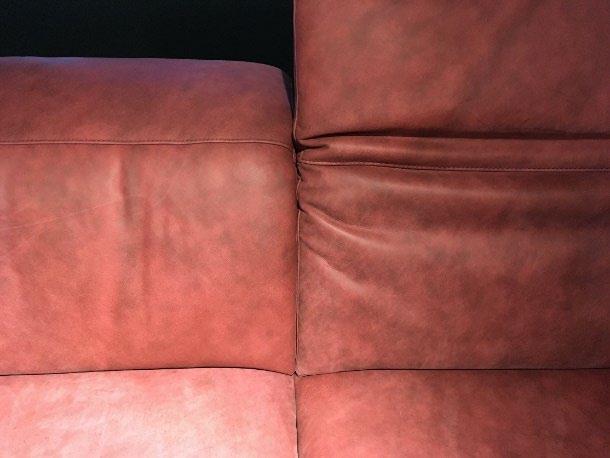
Upholstered furniture with chamber cushions
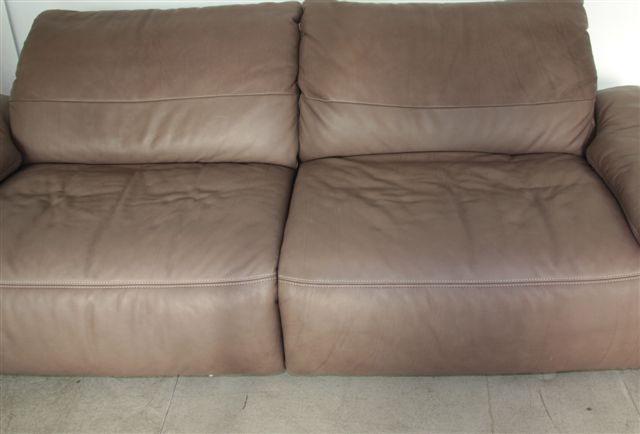
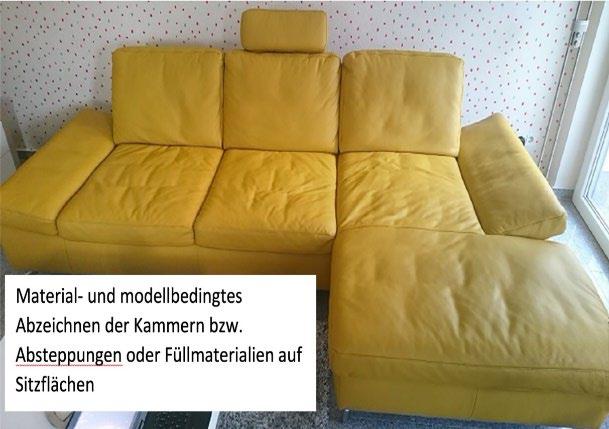
Material and modelrelated marking of the chambers or quilting or filling materials on seating surfaces

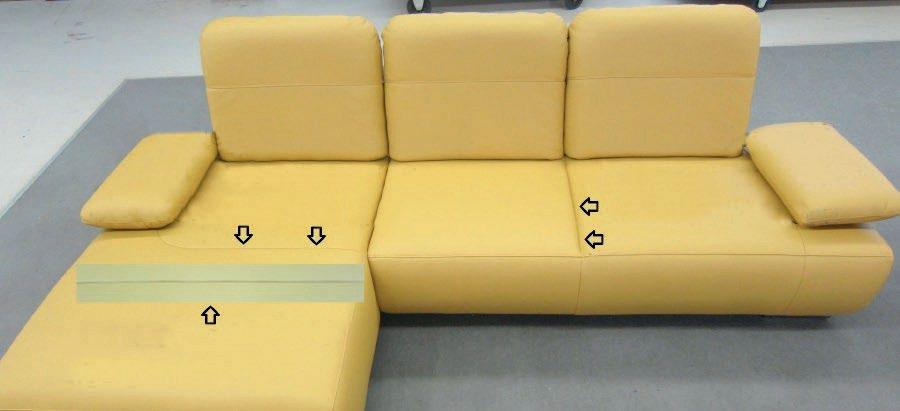
Overlaying dividing seam. Not connected to upholstery or frame
Detailed view of the dividing seam
Construction seam. Connected to upholstery or frame



Construction seam
Dividing seam

Measurements are taken from seam to seam, including any curvature of the upholstery.
If the seat width is interrupted by a dividing seam, this should not be taken into account when evaluating the seat width for measurement (see picture above).
Division of the upholstery areas – E = element
L1 = seat width element E1
L2 = seat width element E2
L3 = largest seat width element E3
L4 = different seat width with diving seam E4

13.7.1. Upholstered furniture – Table for permissible ripple formation
Depending on the seat width according to RAL-GZ 430
This table serves as a guideline for the assessment of ripples on the seating surface of upholstery furniture (not for backrests). The calculation is based on a seat width of 700 mm. Here, a ripple height of no more than 20 mm may occur after the cover has been smoothed together towards the centre. The ripple measurement is carried out by means of a ripple measuring device (aid), which is placed above the ripple created after the cover has been folded.
Exception: This procedure must not be followed for particularly casual models where the cover cut has been kept slightly larger for design reasons or where the upholstery construction has been made with softer materials (e. g. down covers, especially fine padding, mat covers, belt under-springing, etc.). These guide values cannot be applied here. In this case, the ripple formation can be more pronounced without a justified complaint.

13.8. Odour test for furniture leather
Quick method based on VDA 270 and RAL-GZ 430
Aim: The simplified odour test is intended as an incoming goods inspection for furniture manufacturers and as an orienting test in the event of odour complaints from customers.
Test procedure: The test is carried out in accordance with VDA 270 with the following changes and concretisations:
a) Test equipment and chemicals:
• 1-litre jar with odourless screw cap. The jars must be thoroughly cleaned and baked out (80 to 100° C).
• 100 ml beaker
• Saturated sodium chloride solution with sufficient sediment (Corresponds to 75% rel. humidity)
b) Sample size:
The sample area is 10 cm2 (5 cm x 2 cm). This corresponds to a sample area/sample volume ratio of 1 m2 / 1 m3.
c) Storage conditions:
The samples are stored for 24 h at 23° C ± 2° C in a tightly closed glass. To adjust the relative humidity to 75%, the 100 ml beaker filled with 50 ml of saturated NaCl solution is placed in the glass jar. It must be ensured that the sample to be examined has no direct contact with the salt solution.
d) Grading scale (according to RAL-GZ 430):
1 = no odour
2 = weak odour
3 = distinctive, not unpleasant odour
4 = unpleasant odour
5 = unbearable odour
e) Evaluation:
The individual marks are averaged and rounded to half marks.
Example: Mean value 2.1 = Grade 2

Mean value 2.3 = Grade 2.5
Mean value 2.8 = Grade 3
Acceptance/rejection criterion: so far 3.5 with elimination of the maximum and minimum value for 7 test persons (non-smokers), 3 of whom must be female.
13.9. Odour test for foam materials
Quick method based on VDA 270 and RAL-GZ 430 (15)
Aim: The simplified odour test is intended as an incoming goods inspection for furniture manufacturers and as an orienting test in the event of odour complaints from customers.
Test procedure: The test is carried out in accordance with VDA 270 with the following changes and concretisations:
a) Test equipment and chemicals:
• 1-litre jar with odourless screw cap. The jars must be thoroughly cleaned and baked out (80 to 100° C).
• 100 ml beaker
• Saturated sodium chloride solution with sufficient sediment (Corresponds to 75% rel. humidity)
b) Sample size: (50 x 50 x 20 mm)
The sample size is (50 ± 5) cm3. This corresponds to a loading volume of 50 cm3/l.
c) Storage conditions:
The samples are stored for 24 h at 23° C ± 2° C in a tightly closed glass. To adjust the relative humidity to 75%, the 100 ml beaker filled with 50 ml of saturated NaCl solution is placed in the glass jar. It must be ensured that the sample to be examined has no direct contact with the salt solution.d) Grading scale (according to RAL-GZ 430):
1 = no odour
2 = weak odour
3 = distinctive, not unpleasant odour
4 = unpleasant odour
5 = unbearable odour

e) Evaluation:
The individual marks are averaged and rounded to half marks.
Example: Mean value 2.1 = Grade 2
Mean value 2.3 = Grade 2.5
Mean value 2.8 = Grade 3
Acceptance/rejection criterion: so far 3.5 with elimination of the maximum and minimum value for 7 test persons (non-smokers), 3 of whom must be female.
PUR standard foam
Foam of types MB and MM according to EN ISO 5999 with a rebound resilience, measured according to ISO 8307, of greater than 15% and less than 50%. The molecular weight of conventional PUR foams is between 3,000 and 3,500 Dalton.
Note: Another characteristic of PUR standard foam, in contrast to HR foam, is the crystalline urea that predominantly forms during production. Due to the different morphology of PUR standard foam compared to PUR cold foam, it can be clearly identified using IR spectroscopy.
PUR polyurethane foam according to EN ISO 5999 of the types MB, HB and HM, produced with highly reactive polyols and a closed-cell pore structure, which is broken up after production by crushing for better air permeability and has a rebound resilience of more than 50%, measured according to DIN ISO 8307. The molecular weight of PUR cold foams is between 5,000 and 6,000 Dalton.
Note: Further characteristics of PUR cold foam, also known as HR foam (HR = High Resilient), is a SAG factor according to EN ISO 2439 of at least 2.5 and the amorphous or dissolved carbonic acid diamide (urea) that is formed exclusively during production.

Foam of types LB and LM according to EN ISO 5999 with predominantly viscous behaviour, in which the rebound resilience measured according to DIN ISO 8307 is at most 15%.
Note: Two types of viscous foam are distinguished. Pneumatic viscous foam with predominantly closed or microporous cells and chemical viscous foam with open cells. In terms of the dependence of its mechanical properties on temperature, pneumatic foam is less sensitive than chemical viscous foam.
PUR hypersoft foam is an extremely soft, elastic, supple and air-permeable PUR foam for nonload-bearing purposes as defined in DIN EN ISO 5999 with compressive stress values below 2.0 kPA or indentation hardness below 80 N, in which carbon dioxide is added during production or a special polyol is used and in which the chain ends produced by polyaddition contain almost exclusively primary OH groups.
Note: PUR hypersoft foam is suitable for the production of mattress toppers and cushions as well as for upholstered furniture as a cover layer between the load-bearing foam and the cover fabric.
Gel foam is a relatively new PUR soft foam of a rather viscous character, which is produced with organic or synthetic gel particles or binds them.
The rebound resilience is approx. 15% according to DIN EN ISO 8307, resulting in an assignment to the group of viscous soft foams according to DIN EN ISO 5999. The other technical characteristics according to DIN EN ISO 5999 (Flexible elastic polymer foamsPolyurethane foams for upholstery purposes with the exception of carpet underlays) vary, which makes a clear classification according to DIN EN ISO 5999 difficult.
Note: Further specification is currently being discussed among experts. A number of inaccurate statements are made about gel foam in the trade – further specification in the definition is therefore necessary.

13.11. Explanation of the term “force majeure”
Definition Deutsche Gütegemeinschaft Möbel e. V.
(Member of RAL German Institute for Quality Assurance and Labelling e. V.)
1. Definition
In general, the term "force majeure" is understood to mean an event that comes from outside, has no operational connection and cannot be averted even by the utmost diligence that could reasonably be expected (instead of many: BGHZ 100, 185). Events such as natural disasters (hurricanes, earthquakes, or floods), (local) epidemics, pandemics, wars, and political unrest are usually regarded as "force majeure". Official measures and warnings are also a strong indication of the existence of force majeure. 1
The supplier and the customer agree that the following circumstances are also to be attributed to force majeure:
o Transport and freight delays for which the supplier is not responsible (in particular in the event of delayed receipt despite timely handover of the goods from the Supplier to the transport person)
o Operational disruptions for which the supplier is not responsible or pandemic capacity reductions of any kind due to a lack of manpower, energy, preliminary products, raw materials and untimely or improper own preliminary supply of the supplier (interruption of the supply chains), which significantly change the economic significance or the content of the delivery or have a significant effect on the supplier's operations
o Damage at the supplier or his sub-suppliers caused by natural disaster
o Strikes or labour disputes including lawful lockouts
o Attacks on the supplier's IT system which are detrimental to the production process
o Delays for which the supplier is not responsible due to difficulties in obtaining the necessary official approvals
o In case of border closure or official measure, instruction, or warning
2. Legal consequences due to force majeure as defined under Item 1
A contracting party who is unable to deliver in accordance with the contract due to force majeure shall be obliged to inform the contractual partner immediately of the reason and the expected duration of the delay in delivery. At the request of the contractual partner, the supplier shall be obliged to explain the objective existence of the force majeure and the effects on the ability to deliver.
Contractual delivery periods shall be automatically extended by the duration of the hindrance due to force majeure. Other reasons for delay may not be taken into account. Claims for damages, contractual penalties, or termination/withdrawal from the contract due to the delay in delivery on account of force majeure may not be asserted.
In the event of delays in delivery due to force majeure, the contract shall be adjusted appropriately at the request of either party in good faith. Insofar as this is not economically justifiable from the supplier's point of view, the supplier shall have the right to withdraw from the contract.
Fürth, November 2021
1 Case law
Case law has ruled that the term “force majeure” within the meaning of travel law may include war, a terrorist attack, massive violent unrest (LG Frankfurt a. M. RRa 2015, 8; also BT-Drs. 8/2343, p. 12), a reactor accident (BGHZ 109, 224) or the outbreak of an epidemic such as SARS (AG Augsburg 14 C 4608/03).

13.12. Emission class for furniture according to RAL-RG 437
For the members of the DGM, healthy living has been a focus for many years. There has been great progress due to environmental protection and building refurbishment over the last few decades. Our homes have become increasingly tight due to thermal insulation systems and windows that seal properly. Natural air exchange is only possible through thorough ventilation or automatic ventilation systems, such as in low-energy houses or public buildings.
Pollutants can be emitted from a wide range of different products, such as building materials, adhesives, wallpaper, varnishes, furnishing materials or furniture. Therefore, all materials used indoors must be low in harmful substances and release as few emissions as possible into the ambient air.
In cooperation with leading testing institutes such as TÜV Rheinland and eco-INSTITUT, a group of DGM experts has developed emission classes for furniture. The objective was to develop a label that provides the consumer with the most important information on the emission profile in a simple way. This seems to be useful for a risk assessment in our opinion since the legislator does not specify limit values for many pollutants. Emission class A signifies a low risk of exposure to pollutants.
The emission label can be awarded to the following collections/models:
Seating furniture
Cabinet furniture
Tables
Office furniture
Slatted frames
Mattresses
Beds
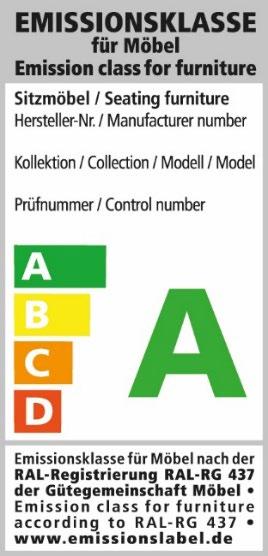
The basic principles are stipulated in the RAL registration RAL-RG 437 Emission classes for furniture.
An emission label provides the consumer with information on pollutant emissions and is intended to protect the consumer from detrimental health effects. The emission label developed by the Deutsche Gütegemeinschaft Möbel e. V. refers to a collection / a model and is attached directly to the product/s. Proof of classification is based on appropriate pollutant tests, and the label is awarded exclusively by the Deutsche Gütegemeinschaft Möbel e. V.

13.13. Climate neutral furniture manufacturer for the furniture industry according RALGZ 435
To mark their sense of responsibility towards climate change, furniture manufacturers can have themselves certified with regard to the Climate Pact. This provides consumers with an additional basis for decision-making, as it shows them that they are dealing with a piece of furniture whose manufacturer attaches importance to climate protection. In the further development of the climate pact, there is the possibility of being specially distinguished as a climate neutral furniture manufacturer. The award is made exclusively by the Deutsche Gütegemeinschaft Möbel e. V.
The foundation of the Climate Pact is a company's carbon footprint. Furniture manufacturers who join the pact have their “footprint” calculated annually by a neutral body on the basis of applicable standards. This footprint is made up of direct and indirect greenhouse gas emissions.
Scope 1: Direct emissions of the company resulting from the consumption of primary energy sources
= Burning of fossil raw materials for energy production, heat generation, fuels for company-owned cars and trucks, process emissions, and refilling of cooling and air-conditioning systems.
Scope 2: Indirect emissions resulting from the generation of self-procured energy = Secondary energy sources such as electricity, district heating, steam, or cooling energy.
Scope 3: All indirect emissions resulting from the operation of all daily business processes and the product life cycle
= Mining and processing of raw materials, consumables and supplies, upstream chains of fuels, thermal energy, process energy and electricity production, employee travel, external logistics, business flights, business travel incl. overnight stays, commercial waste, paper and cardboard consumption, water consumption.
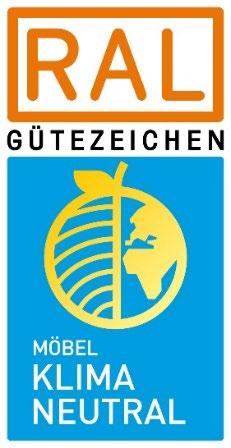

The Ten Principles of

1. Businesses should support and respect the protection of internationally proclaimed human rights.
2. Businesses should make sure that they are not complicit in human rights abuses.
3. Businesses should uphold the freedom of association and the effective recognition of the right to collective bargaining.
4. Businesses should uphold the elimination of all forms of forced and compulsory labour.
5. Businesses should uphold the effective abolition of child labour.
6. Businesses should uphold the elimination of discrimination in respect of employment and occupation.
7. Businesses should support a precautionary approach to environmental challenges.
8. Businesses should undertake initiatives to promote greater environmental responsibility.
9. Businesses should encourage the development and diffusion of environmentally friendly technologies.
10. Businesses should work against corruption in all its forms, including extortion and bribery.